Switzerland is home to an impressive array of birds, with over 200 species to be found in the country.
From the majestic golden eagle to the delicate snow finch, the birds of Switzerland can be seen soaring in the skies, nesting in the trees, and hopping along the country’s beautiful mountain trails.
From small passerines to large waterfowl, the birds of Switzerland are a sight to behold. They provide a unique insight into the country’s diverse habitats, and their presence can be seen as a sign of a healthy environment.
1. Tit
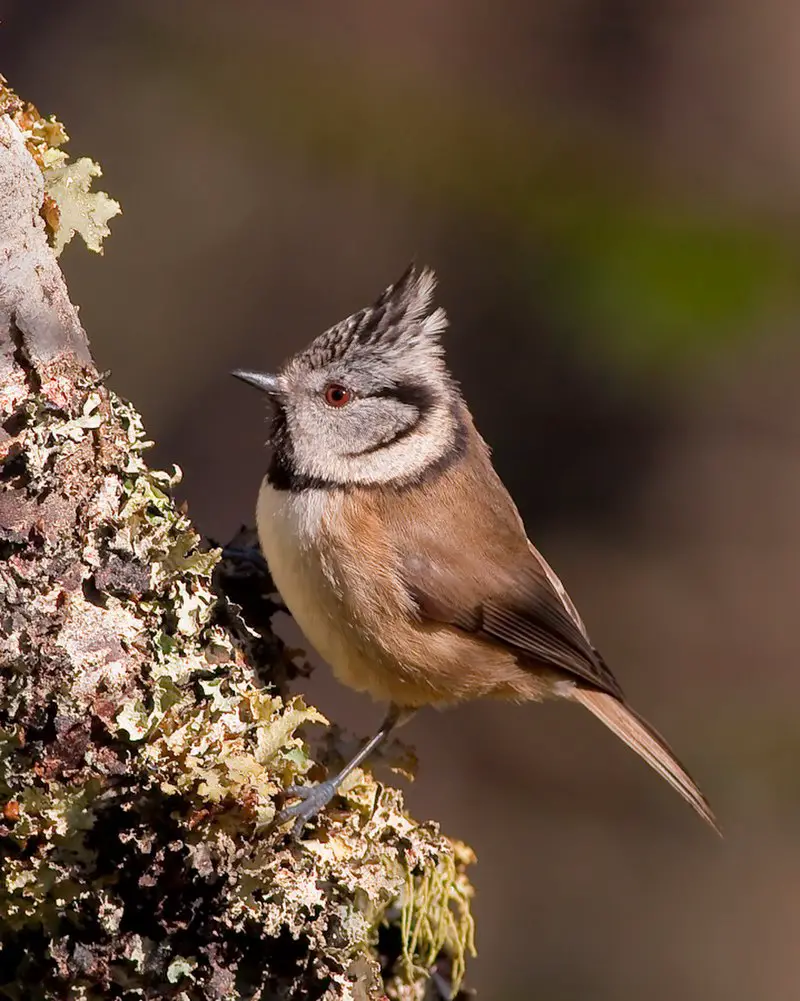
Tit birds are small passerine birds belonging to the family Paridae, found mainly in Northern Hemisphere and Africa.
These active little birds can be seen singing sweet songs throughout the day or scavenging for food at feeders.
They have short, stout bills which they use to crack open seeds and nuts with ease. Tit species range from chickadees to titmice; all of them sport a distinctive black head cap that stands out against their pale grey bodies.
Their bright eyes allow them excellent vision while searching for food – even on gloomy days when other predators may not see as well.
Tits are an important part of any healthy ecosystem and provide many ecological services such as insect control and seed dispersal.Scientific classification:
| Kingdom | Animalia |
| Phylum | Chordata |
| Class | Aves |
| Order | Passeriformes |
| Infraorder | Passerida |
| Family | Paridae Vigors, 1825 |
2. House Sparrow
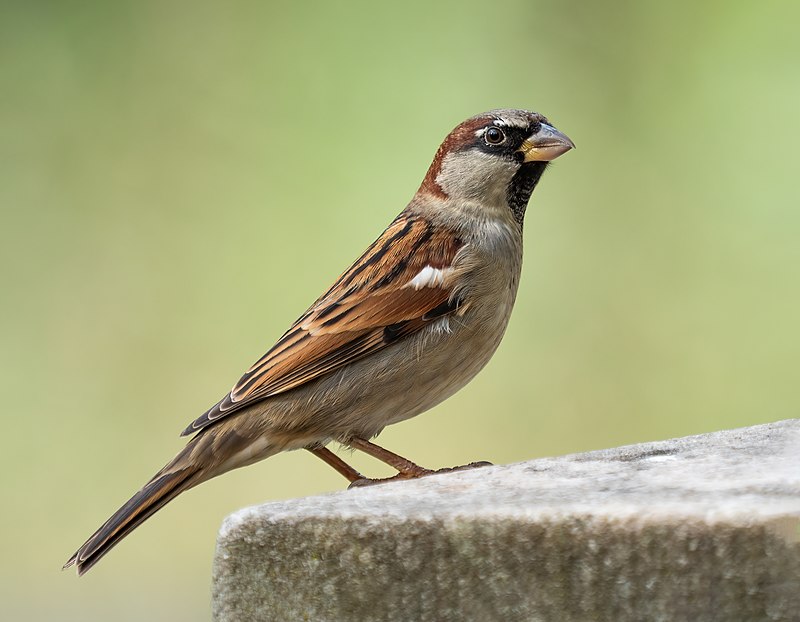
The house sparrow is a small bird of the Passeridae family. It has an average length of 16 cm and weighs 24-39.5 gm.
Females have dull brown and grey plumage, whereas males are brighter, with black, white and brown markings on their wings and back feathers.
This species is one among 25 different kinds in its genus Passer .These birds are found all around the world mainly near human dwellings where they feed off food scraps from garbage bins or gardens etc..
They also make nests close to houses which makes them even more visible to people living nearby.
House sparrows can be seen hopping around yards looking for food during daytime hours but usually hide in colonies at night time.Scientific classification:
| Kingdom | Animalia |
| Phylum | Chordata |
| Class | Aves |
| Order | Passeriformes |
| Family | Passeridae |
| Genus | Passer |
| Species | P. domesticus |
3. Great Spotted Woodpecker
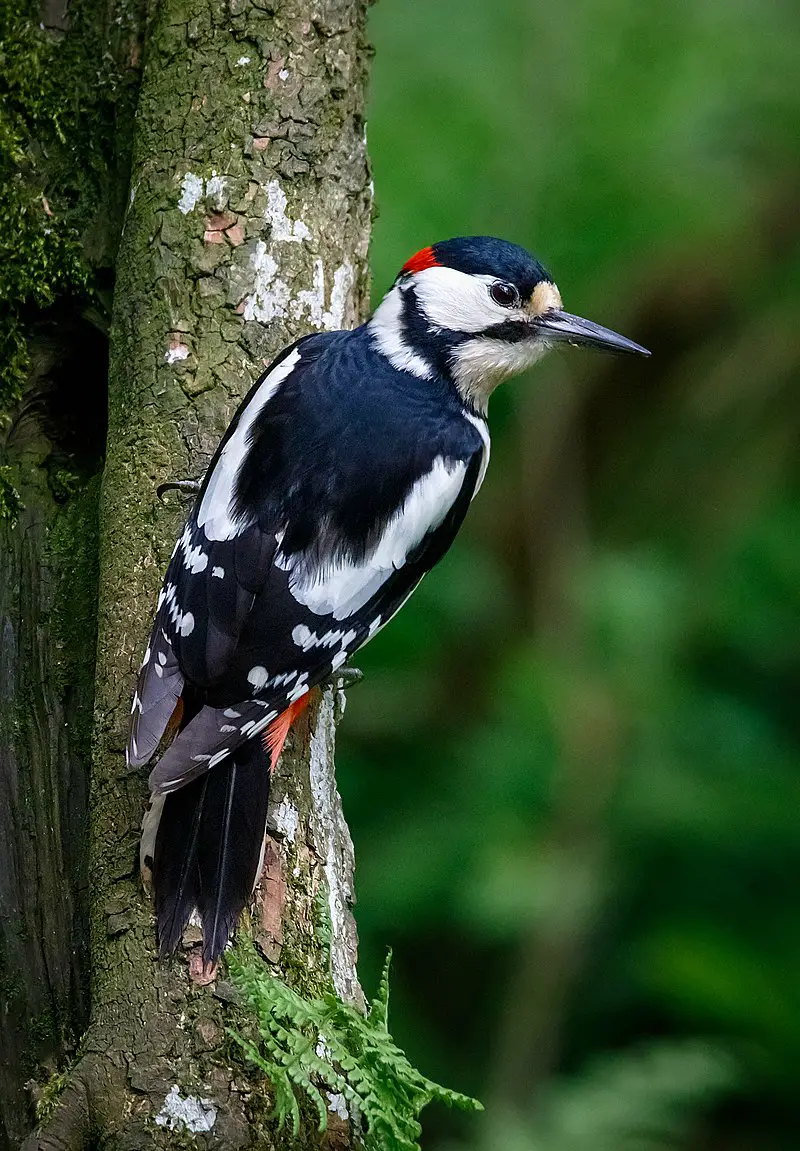
The Great Spotted Woodpecker is a fascinating bird. It has black and white feathers, with red patches on its lower belly and head or neck depending on whether it’s male or young.
This species inhabits most of the Palearctic region as well as some parts of North Africa.
For much of its range, it remains in one place all year round but may migrate if food sources become limited further north.
Its diet consists mainly of insects found under tree bark along with small amounts of seeds and fruit when available.
Despite being quite vocal they are hard to spot due to their camouflaged feathers which helps protect them from predators like cats and birds-of-prey.Scientific classification:
| Kingdom | Animalia |
| Phylum | Chordata |
| Class | Aves |
| Order | Piciformes |
| Family | Picidae |
| Genus | Dendrocopos |
| Species | D. major |
4. Eurasian Jay
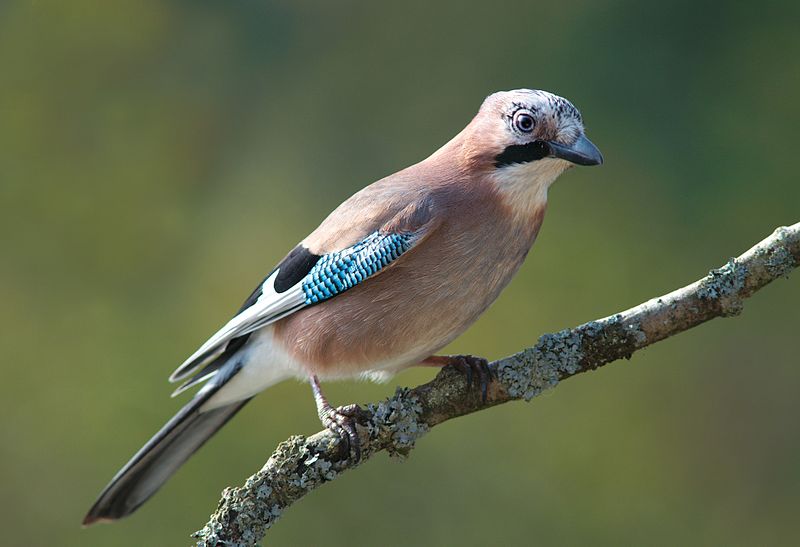
The Eurasian jay is a beautiful passerine bird of the crow family, Corvidae. It has bright pinkish brown plumage with white throat and two black stripes on each side.
The upper wings have an eye-catching blue panel while its tail is all black in color. This species mainly resides in woodlands, spanning over vast regions from western Europe to India and even north-west Africa.
Its diet consists of small invertebrates like insects as well as fruits, seeds and nuts making it quite adaptable when it comes to food sources.
With its loud calls echoing through the forests they inhabit, this amazing creature will definitely make your day brighter if you ever get the chance to spot one.Scientific classification:
| Kingdom | Animalia |
| Phylum | Chordata |
| Class | Aves |
| Order | Passeriformes |
| Family | Corvidae |
| Genus | Garrulus |
| Species | G. glandarius |
5. Common Swift
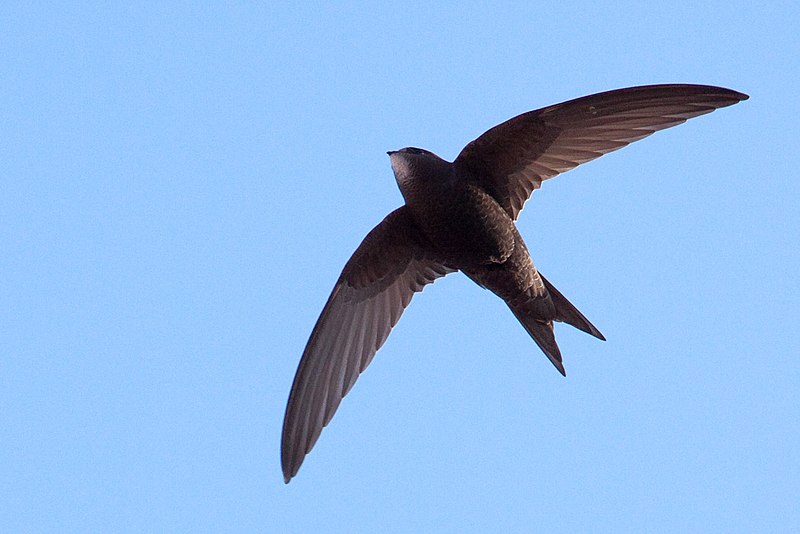
The Common swift is a medium-sized bird with an appearance similar to the barn swallow or house martin.
Its wings are larger, however it is not related to these species but instead belongs in its own order of Apodiformes.
The similarities between the two groups have come about due to convergent evolution and a shared environment.
As for relatives, they can be found among New World hummingbirds and South American swifts; whereas more distant cousins include nightjars as well as treeswifts from Asia/Africa and Australian swiftspecies.
These birds live up high in the air where they remain on constant flight even when sleeping or eating.
They usually migrate south during winter months then return again each springtime bringing life back into our skies.Scientific classification:
| Kingdom | Animalia |
| Phylum | Chordata |
| Class | Aves |
| Order | Apodiformes |
| Family | Apodidae |
| Genus | Apus |
| Species | A. apus |
6. Bearded Vulture
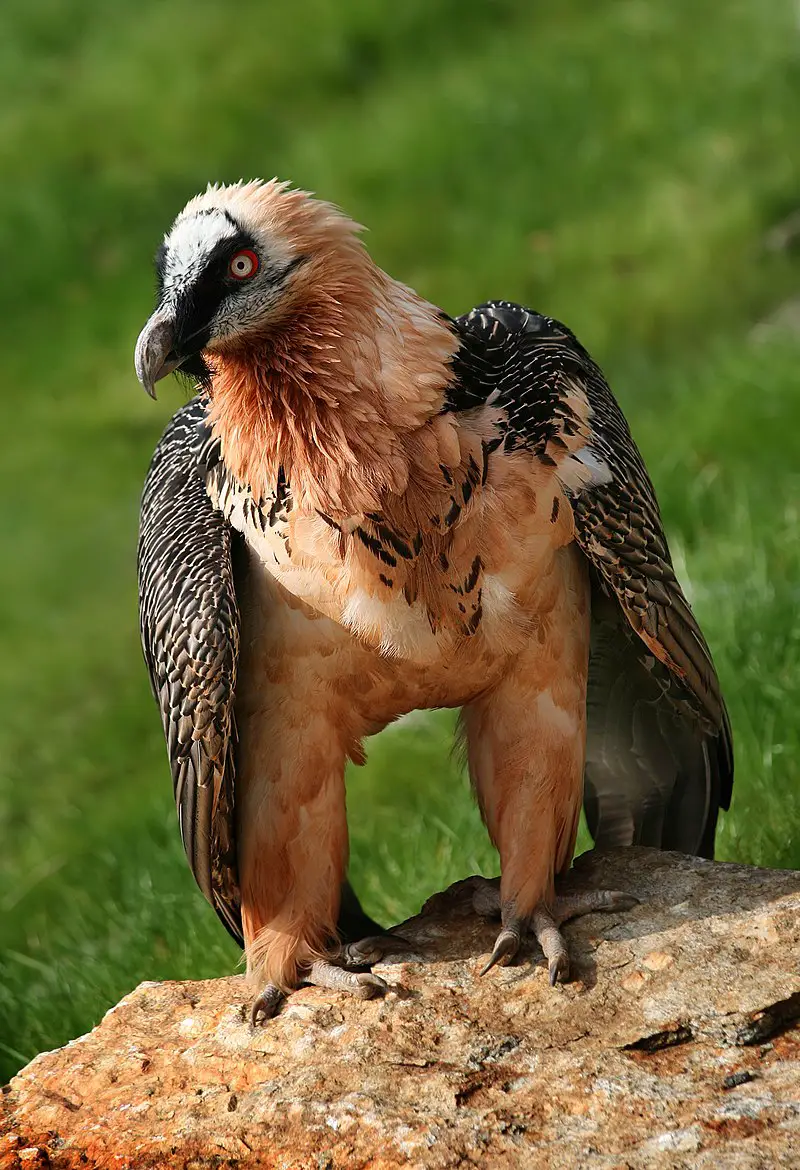
The Bearded vulture, also known as the lammergeier and ossifrage, is a majestic bird of prey belonging to its own genus within Accipitridae. It has an impressive wingspan that can reach up to 2.5m wide.
Its habitat ranges from Europe through Africa and into parts of Asia, where it prefers rocky areas with cliffs or mountainsides for nesting sites.
The bearded vulture’s diet consists mainly of carrion but it will occasionally feed on small mammals such as rabbits or hares too – using their powerful beak to crack open bones in order to get at the nutritious marrow inside.
These birds are highly endangered due primarily to human interference so conservation efforts must continue in order for us all have them around for future generations.Scientific classification:
| Kingdom | Animalia |
| Phylum | Chordata |
| Class | Aves |
| Order | Accipitriformes |
| Family | Accipitridae |
| Genus | Gypaetus Storr, 1784 |
| Species | G. barbatus |
Also Featured In: Birds that Live in the Deserts, East African Birds
7. Eurasian Wren
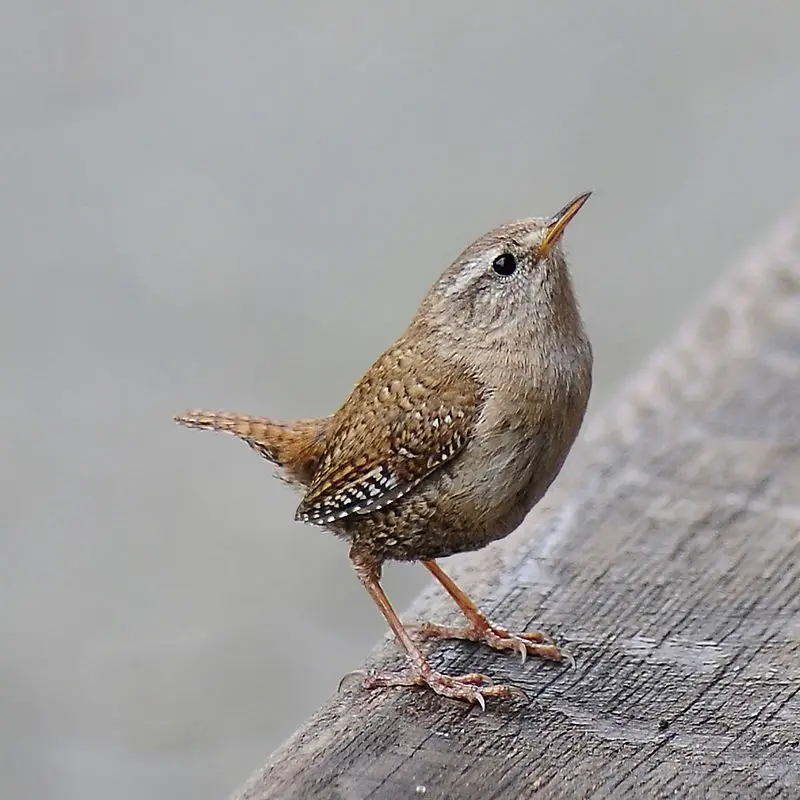
The Eurasian Wren is a small, insectivorous bird that can be found throughout Europe and Africa.
It has russet-brown upperparts with paler buff-brown underparts and its most notable feature is its short tail which it holds upright in flight or when perched.
Its neck is also quite short while the bill tends to be long and thin.
The species prefers dense vegetation like hedgerows, woodland edges and parks as well as coastal areas where there are plenty of insects for them to feed on such as spiders, beetles, caterpillars etc..
Their song consists mainly of high notes that vary between regions but usually ends with four or five repeated trills – making them an easily identifiable addition to any garden.Scientific classification:
| Kingdom | Animalia |
| Phylum | Chordata |
| Class | Aves |
| Order | Passeriformes |
| Family | Troglodytidae |
| Genus | Troglodytes |
| Species | T. troglodytes |
8. Bearded Reedling
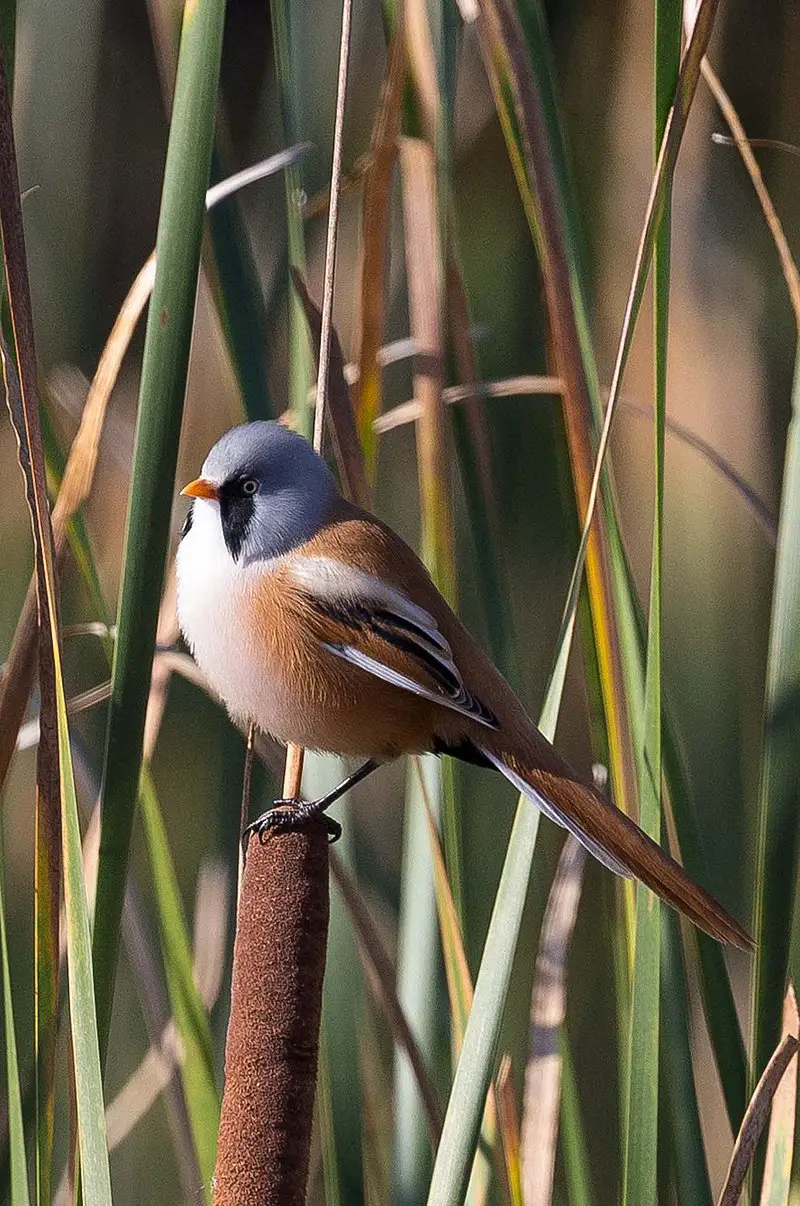
The Bearded Reedling is a small passerine bird found in reed-beds across Europe, Asia and North Africa.
It is easily identified by its distinct black and white plumage with males having yellow faces.
This species belongs to the only family of birds known as Panuridae and was first described by Carl Linnaeus back in 1758.
They feed on insects such as beetles, flies, moths among others but also consume seeds from plants like sedges or rushes during winter months when food availability decreases significantly.
These birds are territorial meaning that they have their own area where they live which can vary from 8 to 12 hectares depending on the seasonality of insect abundance within these areas making them an important part for maintaining healthy ecosystems in wetlands around their range.Scientific classification:
| Kingdom | Animalia |
| Phylum | Chordata |
| Class | Aves |
| Order | Passeriformes |
| Family | Panuridae Des Murs, 1860 |
| Genus | Panurus Koch, 1816 |
| Species | P. biarmicus |
9. Golden Eagle
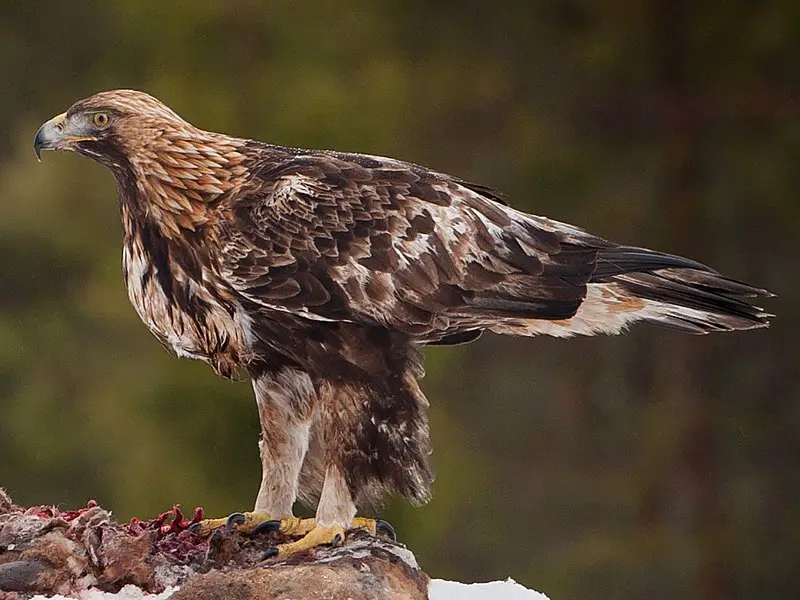
The Golden Eagle is an iconic bird of prey found throughout the northern hemisphere. It is a large, powerful raptor with dark brown feathers and lighter golden-brown plumage on its nape.
Immature eagles have white patches around their beaks, tails and wings which they lose as they mature.
Its diet consists mostly of small mammals such as rabbits, hares and marmots but can also include birds or reptiles depending on where it lives.
These majestic creatures are known for their remarkable strength in flight; using thermal updrafts to soar high into the sky searching for food or simply enjoying the view below them.
They are often seen soaring alone over open expanses looking out for potential threats from other predators like wolves or foxes that may encroach upon their territory.Scientific classification:
| Kingdom | Animalia |
| Phylum | Chordata |
| Class | Aves |
| Order | Accipitriformes |
| Family | Accipitridae |
| Genus | Aquila |
| Species | A. chrysaetos |
10. European Goldfinch
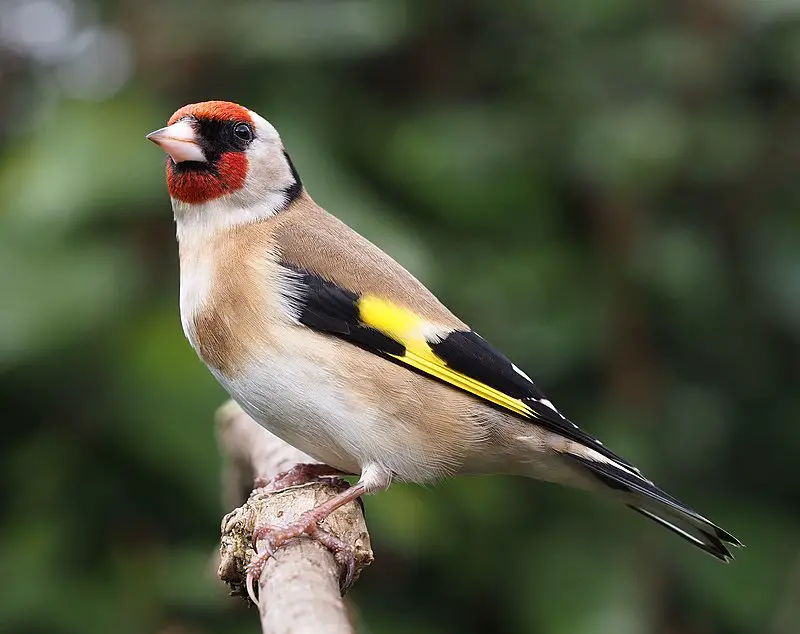
The European Goldfinch is a small passerine bird belonging to the finch family. It inhabits Europe, North Africa, western and central Asia but has been introduced in other places such as Australia, New Zealand and Uruguay.
The breeding male of this species can be easily identified by its red face with black markings around the eyes and black-and-white head.
Its back and flanks are buff or yellowish in color while it has white underparts which contrast well with its dark wings edged in white feathers.
This bird feeds on grains from plants like millet or sunflower seeds along with insects occasionally when available during summer months for food source.
In winter they flock together near sources of water where they find their food among weeds growing there at that time of year.Scientific classification:
| Kingdom | Animalia |
| Phylum | Chordata |
| Class | Aves |
| Order | Passeriformes |
| Family | Fringillidae |
| Subfamily | Carduelinae |
| Genus | Carduelis |
| Species | C. carduelis |
11. Barn Swallow
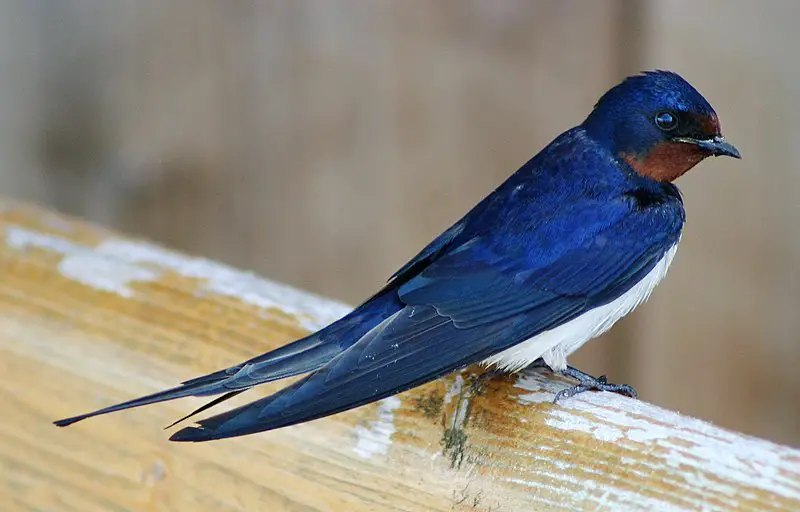
The Barn Swallow is a beautiful passerine bird with blue upperparts and a long, deeply forked tail. Found in Europe, Asia, Africa and the Americas.
It has an astonishingly large natural distribution spanning 251 million square kilometres globally; likely making it one of the world’s most widespread species.
This swallow typically nests near human habitation as well as other open areas such as fields or grasslands which provide them with suitable invertebrate prey to feed on.
They are insectivorous birds that often fly together in flocks looking for food over rivers or marshes usually just above tree-top level.
The barn swallow can also be identified by its strong flight consisting of swift continuous wing beats interspersed with glides during which they hold their wings slightly raised at the shoulders giving them distinct V shaped silhouettes in the sky.Scientific classification:
| Kingdom | Animalia |
| Phylum | Chordata |
| Class | Aves |
| Order | Passeriformes |
| Family | Hirundinidae |
| Genus | Hirundo |
| Species | H. rustica |
12. Black Redstart
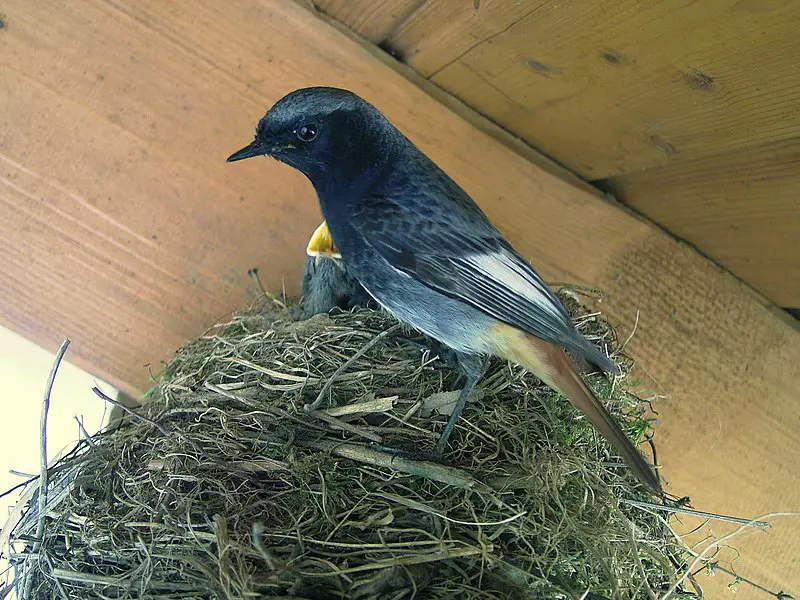
The black redstart is a small passerine bird found in the genus Phoenicurus. It was previously classified as part of the thrush family but now belongs to the Old World flycatcher family.
It has an overall black coloration with striking patches of bright orange or rusty-red on its wings and tail, giving it its name “black redstart”.
The male also sports a prominent crest which he can raise when displaying for females during breeding season.
This species inhabits open woodland areas and generally feeds on insects such as flies, beetles, spiders and caterpillars; although they will supplement their diet with berries where available.
They are often seen perched very prominently from exposed branches near food sources like hedgerows or tree stumps making them easier to spot than some other birds of similar sizeScientific classification:
| Kingdom | Animalia |
| Phylum | Chordata |
| Class | Aves |
| Order | Passeriformes |
| Family | Muscicapidae |
| Genus | Phoenicurus |
| Species | P. ochruros |
13. Black Stork
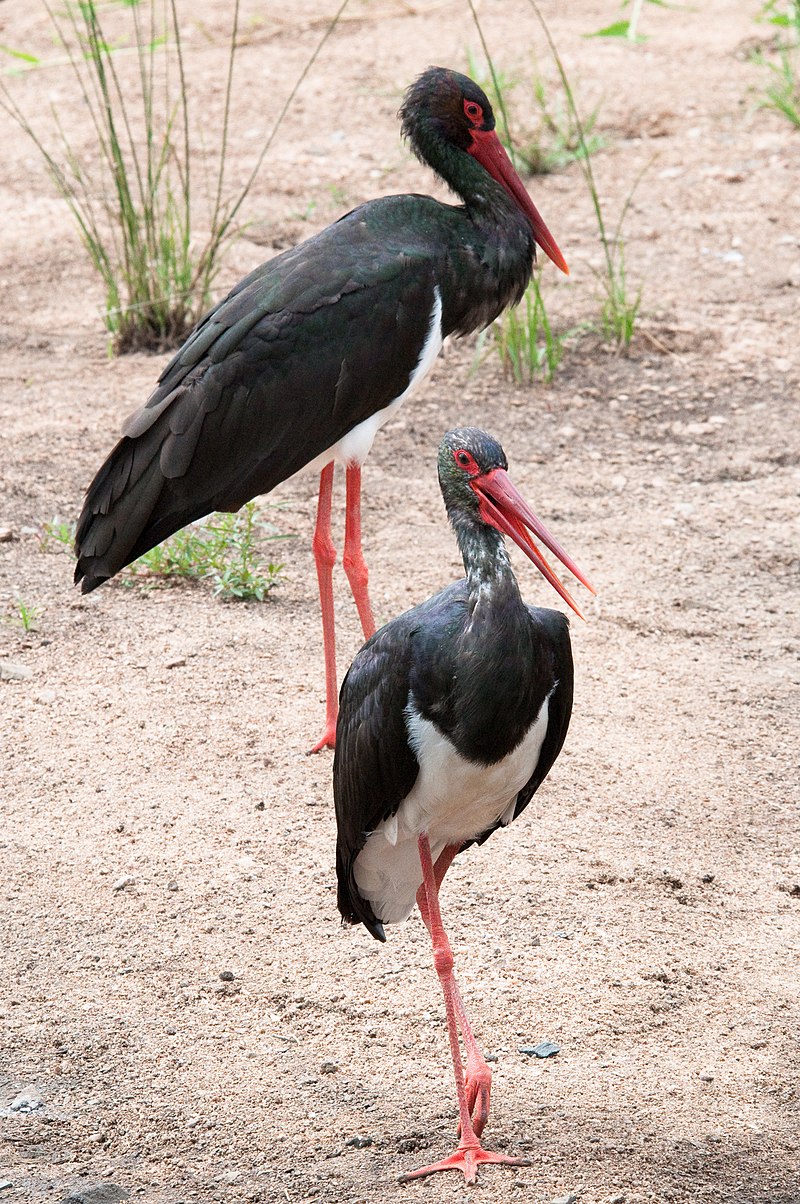
The Black Stork is a majestic bird, with its glossy black feathers and long red legs. Its wingspan ranges from 57 to 61 inches, while it measures an average of 37 to 39 inches tall from beak tip to tail end.
The white underparts contrast perfectly against the dark plumage and are complimented by the vivid red beak.
First described in 1758 by Carl Linnaeus in his “Systema Naturae”, this species has since become popular among bird watchers and naturalists alike for its beauty and gracefulness when flying through the sky.Scientific classification:
| Kingdom | Animalia |
| Phylum | Chordata |
| Class | Aves |
| Order | Ciconiiformes |
| Family | Ciconiidae |
| Genus | Ciconia |
| Species | C. nigra |
14. Northern Storm Petrels
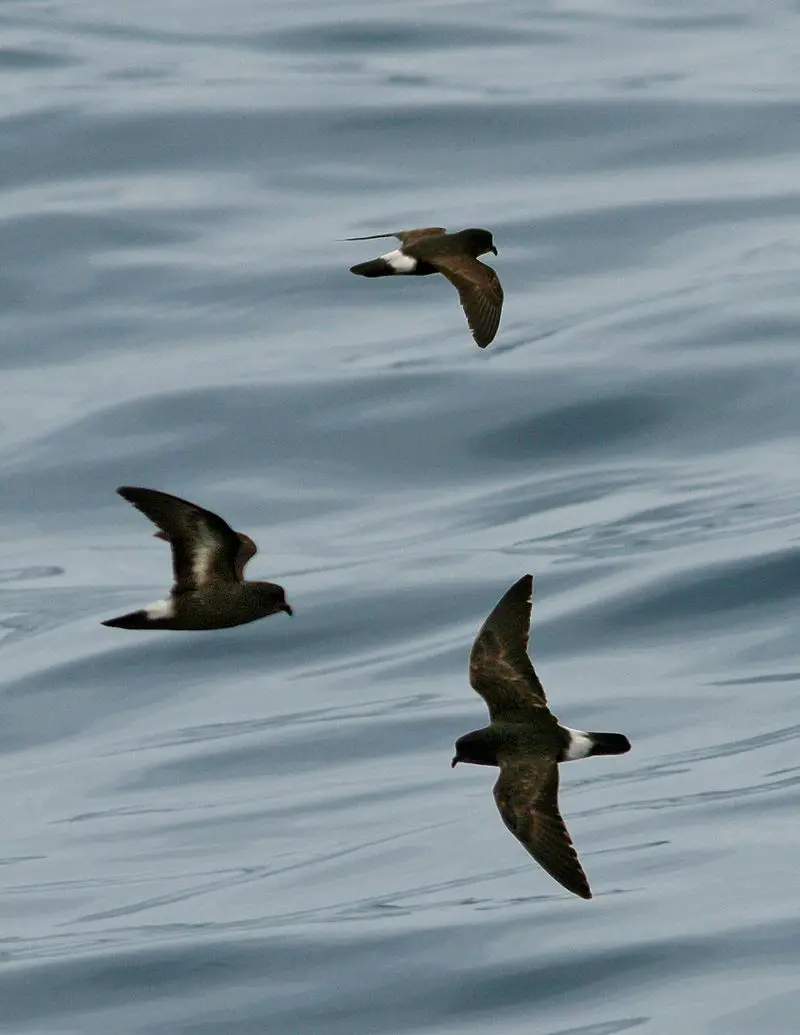
Northern storm petrels are one of the smallest seabirds, inhabiting oceans all over the world.
They have a unique ability to hover over water and pick planktonic crustaceans and small fish from the surface.
Northern storm petrels belong to the genus Hydrobates in family Hydrobatidae, part of Procellariiformes order.
This species was once lumped with austral storm petrel but recent studies show that they weren’t related closely which led them being split into two distinct species now.
These birds can be identified by their dark grey upperparts and wings along with white underparts when seen from afar while feeding on ocean’s surface.Scientific classification:
| Kingdom | Animalia |
| Phylum | Chordata |
| Class | Aves |
| Order | Procellariiformes |
| Family | Hydrobatidae Mathews, 1912 |
| Genus | Hydrobates F. Boie, 1822 |
15. Eurasian Golden Oriole
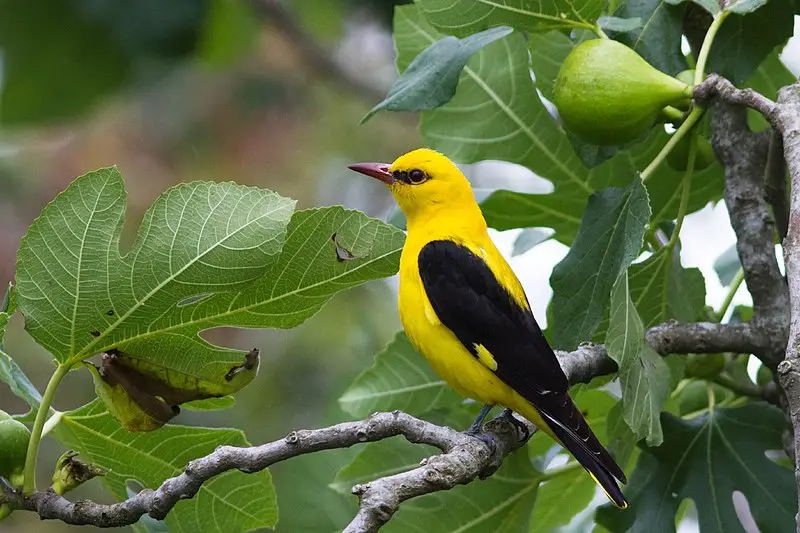
The Eurasian golden oriole is a beautiful bird belonging to the Old World oriole family of passerine birds that breed in temperate climates of the Northern Hemisphere.
It migrates from Europe and Palearctic during summer season, and spends its winter months in central and southern Africa.
These birds have an impressive range with large populations which appear to be stable or increasing across much of their range due to conservation efforts.
They are mostly found near forests, woodlands, riverbanks and meadows where they feed on fruits as well as insects such as caterpillars, beetles, grasshoppers etc.
The males can easily be identified by their bright yellow plumage while females are more olive coloured.
All in all these stunningly colourful creatures add vibrancy to our environment.Scientific classification:
| Kingdom | Animalia |
| Phylum | Chordata |
| Class | Aves |
| Order | Passeriformes |
| Family | Oriolidae |
| Genus | Oriolus |
| Species | O. oriolus |
16. White-Throated Dipper
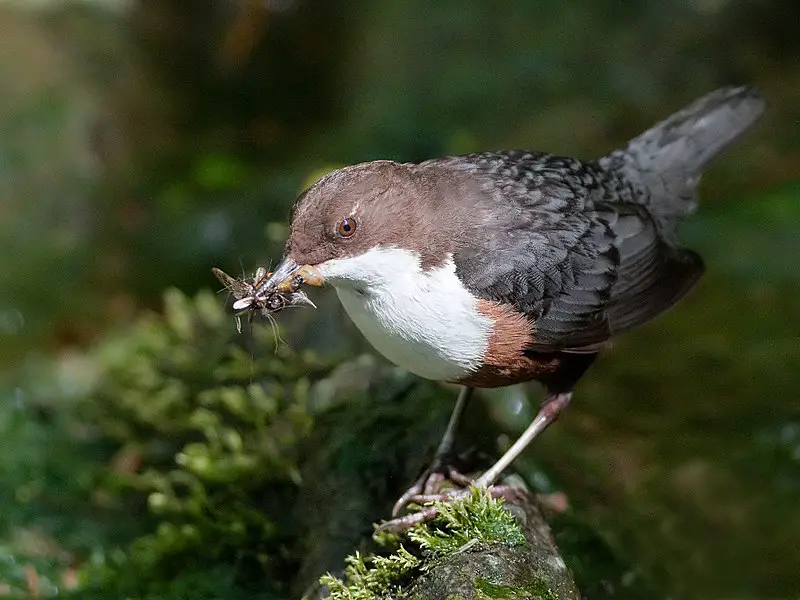
The White-throated dipper is a small aquatic passerine bird found in Europe, Middle East, Central Asia and the Indian Subcontinent. It has several subspecies that vary mainly by colour differences of their pectoral band.
The species prefers fast flowing rivers with clear water where it can be seen diving underwater to search for food like insects and other invertebrates.
They are known to use pebbles as tools when searching for food under rocks on river beds.
This unique behavior earned them the nickname “Nature’s Stone Mason” from some European countries such as Norway which declared it its national bird due to its iconic status among locals who have been observing this fascinating creature since time immemorial.Scientific classification:
| Kingdom | Animalia |
| Phylum | Chordata |
| Class | Aves |
| Order | Passeriformes |
| Family | Cinclidae |
| Genus | Cinclus |
| Species | C. cinclus |
17. Barn Owl
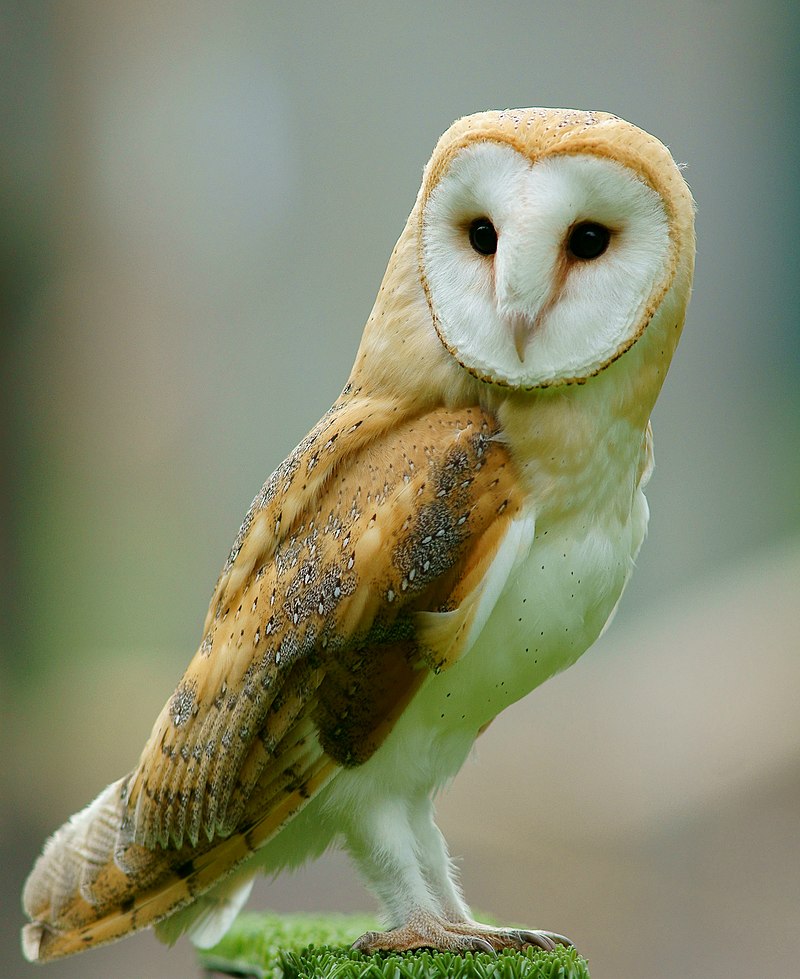
Barn owls are a beautiful and fascinating species of birds found around the world, with the exception of polar and desert regions, most of Indonesia and some Pacific Islands.
They have large eyes, thin legs and long wings that help them to hunt silently in low light conditions.
Their white colouring helps them blend into their surroundings making it easier for them to catch prey.
Barn owls are nocturnal hunters who use their impressive hearing capabilities to locate rodents moving within vegetation or tunnels beneath the ground.
They also feed on insects such as beetles, moths etc., which they can detect from high up in flight using their excellent vision even at night time.
The barn owl plays an important role in balancing ecosystems by controlling rodent populations which is why they should be protected wherever possible so that this vital service continues uninterruptedly.Scientific classification:
| Kingdom | Animalia |
| Phylum | Chordata |
| Class | Aves |
| Order | Strigiformes |
| Family | Tytonidae |
| Genus | Tyto |
| Species | T. alba |
18. Eurasian Reed Warbler
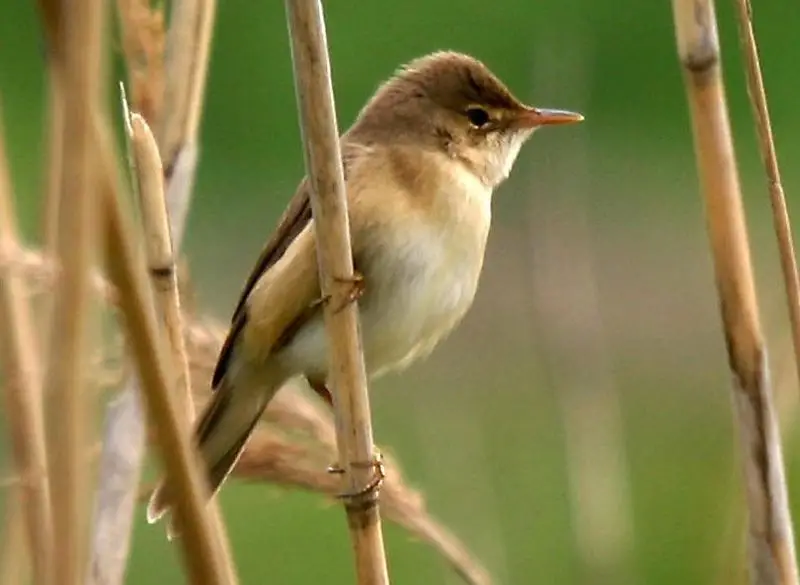
The Eurasian reed warbler (Acrocephalus scirpaceus) is a species of Old World Warbler native to the temperate parts of Europe and Asia.
It breeds in wetlands such as marshes, ponds and rivers with dense vegetation like reeds or tall grasses.
During its wintering season, it migrates southward to sub-Saharan Africa where there are milder conditions.
This small bird has streaked brown plumage on the upperparts and white underparts which makes it difficult for predators to spot among the foliage.
Its diet consists mainly of insects including aphids, caterpillars larvae and moths caught while flying over water or by gleaning from plants growing near water bodies.
The male sings an attractive song consisting of several phrases repeated one after another as part of their courtship display during breeding season in order attract females for mating purposes.Scientific classification:
| Kingdom | Animalia |
| Phylum | Chordata |
| Class | Aves |
| Order | Passeriformes |
| Family | Acrocephalidae |
| Genus | Acrocephalus |
| Species | A. scirpaceus |
19. Black-Headed Gull
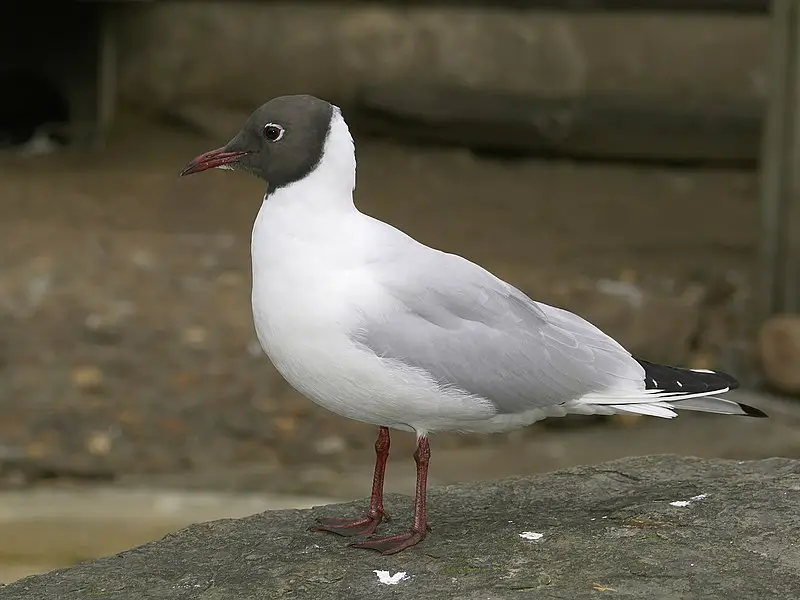
The Black-headed Gull is a small, migratory bird found in much of the Palearctic. It breeds mainly in Europe and coastal eastern Canada but can also be found further west in milder areas.
In North America it’s known as the Common Black-headed Gull.
Its plumage consists of grey on top with white underneath, while its head has a distinctive black cap during breeding season which fades to brown outside of this period.
They are often seen by coastlines or near inland waters where they feed off fish, insects and crustaceans caught either from the surface or underwater depending on their preference at that time.Scientific classification:
| Kingdom | Animalia |
| Phylum | Chordata |
| Class | Aves |
| Order | Charadriiformes |
| Family | Laridae |
| Genus | Chroicocephalus |
| Species | C. ridibundus |
20. Shrike
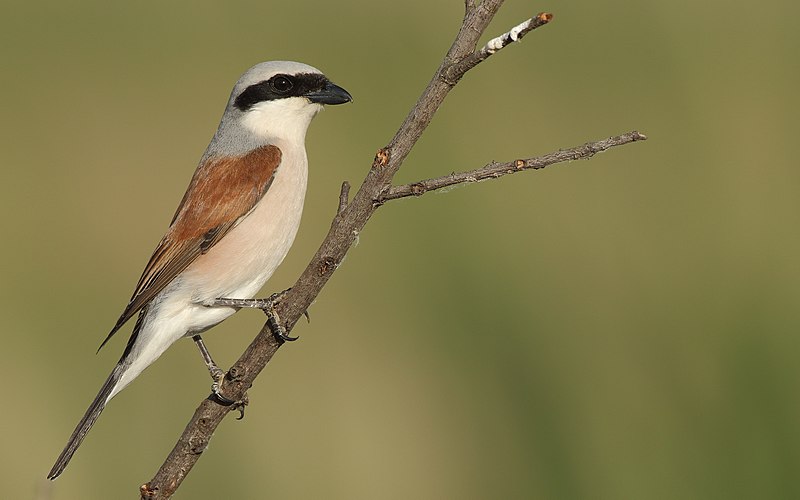
Shrikes are small passerine birds of the family Laniidae, with 34 species in four genera. They get their name from Old English word “scrīc”, which refers to their shriek-like call.
These birds have earned the nickname ‘butcherbirds’ due to their feeding habits; they impale prey on thorns or barbed wire fences for later consumption.
Shrikes also tend to be aggressive predators and hunt a wide range of animals such as insects, small reptiles, rodents and even other smaller bird species.
In terms of physical appearance, these songbirds can vary greatly depending on the specific genus but usually boast a large hooked bill atop an impressive crest along with bright colors like gray, black or brownish hues across its feathers.
It’s clear shrike is quite remarkable creature that has gained notoriety for both hunting prowess and distinctive vocalizations.Scientific classification:
| Kingdom | Animalia |
| Phylum | Chordata |
| Class | Aves |
| Order | Passeriformes |
| Superfamily | Corvoidea |
| Family | Laniidae Rafinesque, 1815 |
21. Black Kite
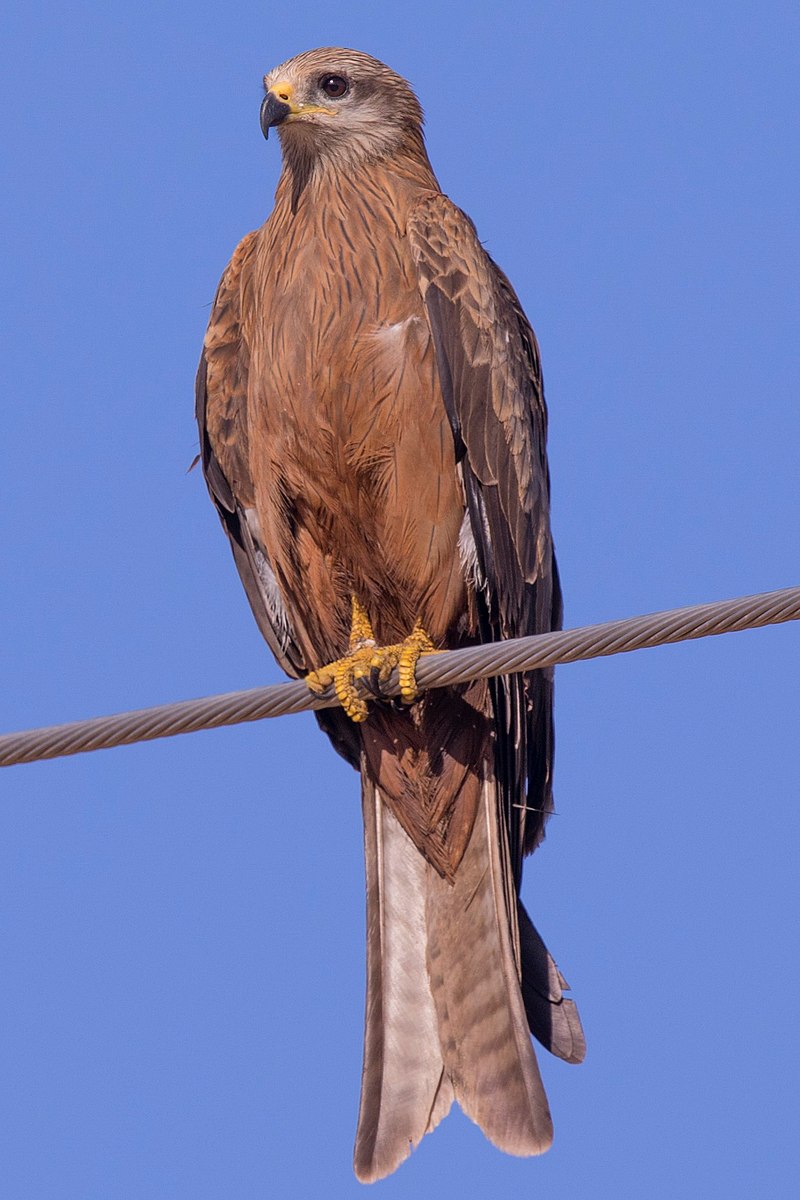
The black kite is one of the most abundant species of diurnal birds of prey in the world, with a global population estimated to be up to 6 million individuals.
It belongs to the family Accipitridae and has medium-sized body size. The wingspan can range from 150 cm – 180cm wide.
They have dark brown feathers on their back and light brown or grey underparts and long forked tails that help it maneuver through.
Its environment while hunting for food like insects, small mammals, reptiles etc., along with scavenging opportunities when available.
Black Kites are found across several continents including Europe, Africa, Asia Minor & Australia where they breed during spring in nests made among trees near wetlands or riversides;
migratory populations move southward away from winter cold temperatures as far east as India & Japan before returning home again next season.Scientific classification:
| Kingdom | Animalia |
| Phylum | Chordata |
| Class | Aves |
| Order | Accipitriformes |
| Family | Accipitridae |
| Genus | Milvus |
| Species | M. migrans |
22. European Green Woodpecker
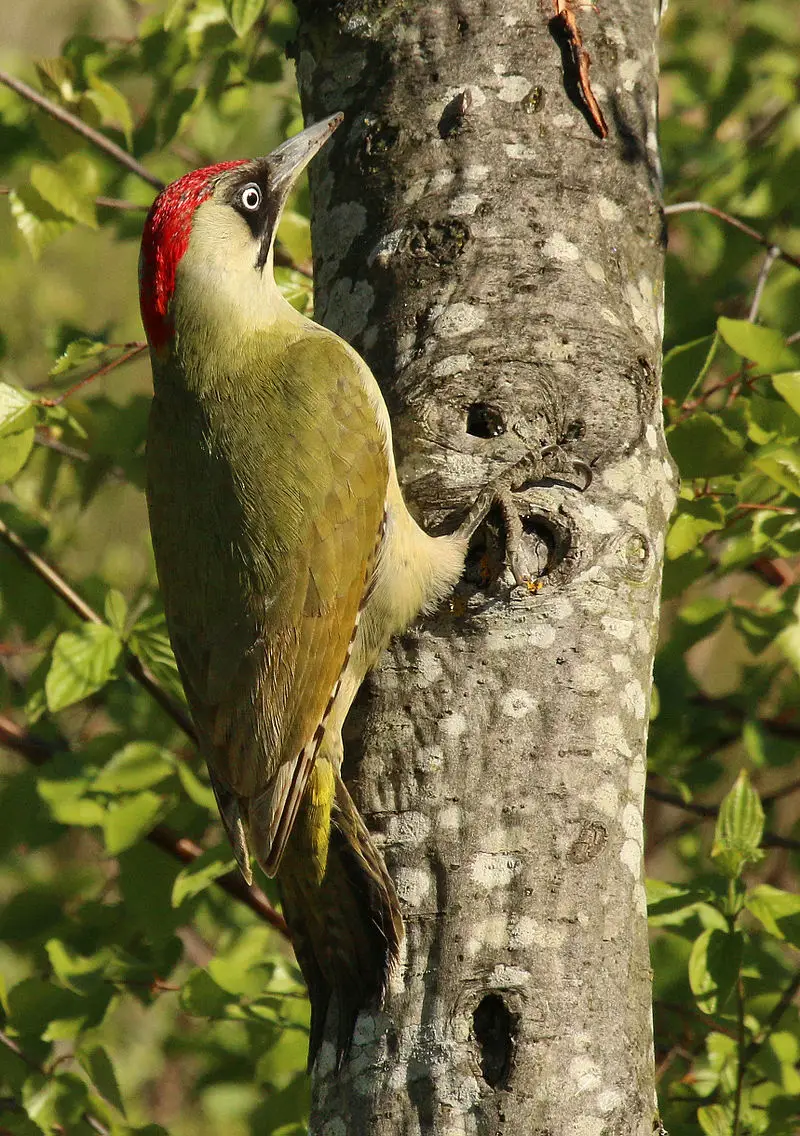
The European green woodpecker is a vibrant species with striking features. The body has an emerald hue, while males have a red crown and black moustache that extends to the middle of their forehead.
Females lack this characteristic feature but instead possess barred markings beneath the wings as well as yellow throats and cheeks.
It can be found in many parts of Europe and western Palearctic regions such as Spain and Portugal where it is replaced by its similar cousin; Iberian green woodpecker (Picus sharpei).
This bird loves inhabiting open forests or grasslands for its food source which typically consists on insects like ants, beetles, spiders among others.
Its powerful bill allows it to dig into tree bark searching for larvae underneath making it an efficient predator in these environments.Scientific classification:
| Kingdom | Animalia |
| Phylum | Chordata |
| Class | Aves |
| Order | Piciformes |
| Family | Picidae |
| Genus | Picus |
| Species | P. viridis |
23. Black Woodpecker
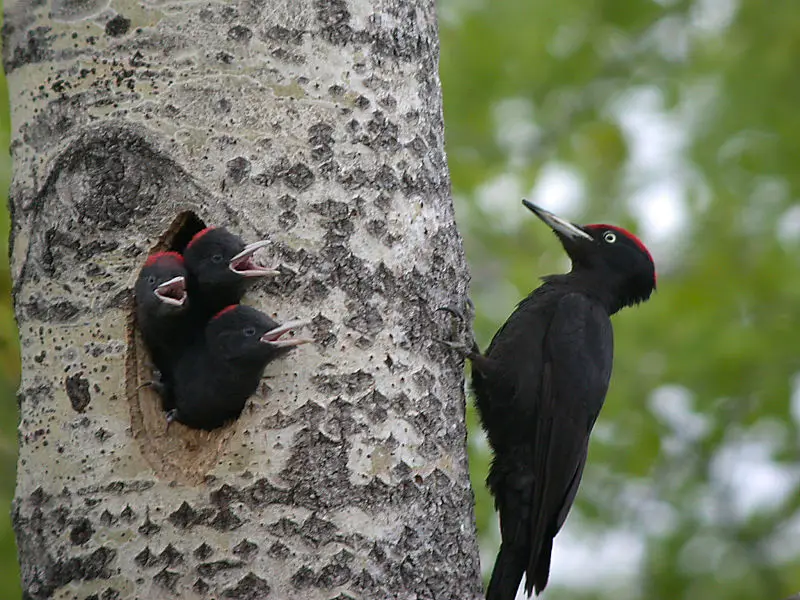
The black woodpecker is an impressive bird found in mature forests across the northern Palearctic region.
It stands out from other species due to its large size and striking black feathers with white spotting on their wings and tail.
Not only is it one of the largest woodpecker species worldwide but also, interestingly, appears to be expanding its range in Europe and Asia as well.
This non-migratory bird loves spending time amongst trees where they can feed off insects which live within tree trunks or branches; tapping away at them with their strong bills until they get a meal.Scientific classification:
| Kingdom | Animalia |
| Phylum | Chordata |
| Class | Aves |
| Order | Piciformes |
| Family | Picidae |
| Genus | Dryocopus |
| Species | D. martius |
24. Sylviid Warblers
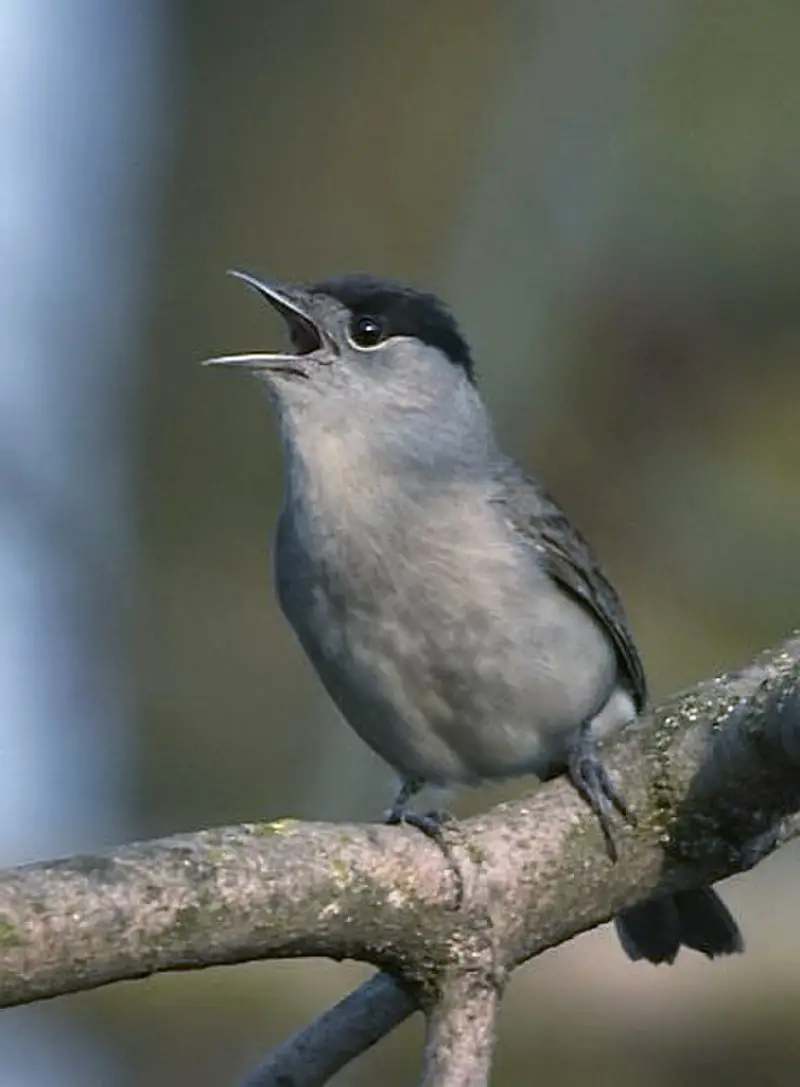
The Sylviid warblers are a family of passerine birds found in Eurasia and Africa. They include the typical warblers as well as babblers that were formerly part of the Old World babbler family.
These birds have slender bodies, pointed wings, long tails and strong legs adapted for ground-dwelling habits like running or hopping along branches.
The male often has bright colors while females are usually duller in coloration with more muted plumage patterns than males.
Some species also show sexual dimorphism where one sex may be larger or smaller than its counterpart; for instance some species may have longer tail feathers on the female side compared to their male counterparts.
Many members of this group feed on insects but some specialize on seeds, fruits, nectar or even frogs.Scientific classification:
| Kingdom | Animalia |
| Phylum | Chordata |
| Class | Aves |
| Order | Passeriformes |
| Superfamily | Sylvioidea |
| Family | Sylviidae Leach, 1820 |
25. Eurasian Penduline Tit
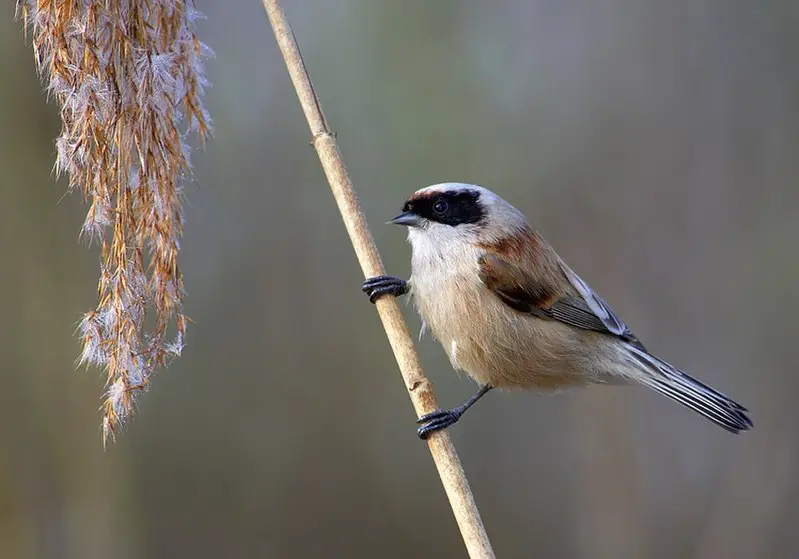
The Eurasian penduline tit is a passerine bird of the genus Remiz which can be found widely across the western Palearctic.
It migrates to more northern parts in summer, while staying resident in its southern range during winter months.
This species experienced an expansion of its breeding grounds throughout Western Europe between 1980s and 1990s, thus increasing its population significantly.
The Penduline Tit has various striking features like bright yellow underparts with black streaks on sides.
Greyish-brown upper part with white underside and pale eye line along head sides as well as distinctive tail nest made from fibers and mosses hanging from trees or shrubs like a pendulum hence their name ‘Penduline’.
These birds feed mainly on insects but also eat some seeds especially sunflower seeds making them popular garden visitors for many people.Scientific classification:
| Kingdom | Animalia |
| Phylum | Chordata |
| Class | Aves |
| Order | Passeriformes |
| Family | Remizidae |
| Genus | Remiz |
| Species | R. pendulinus |
26. Common Kingfisher
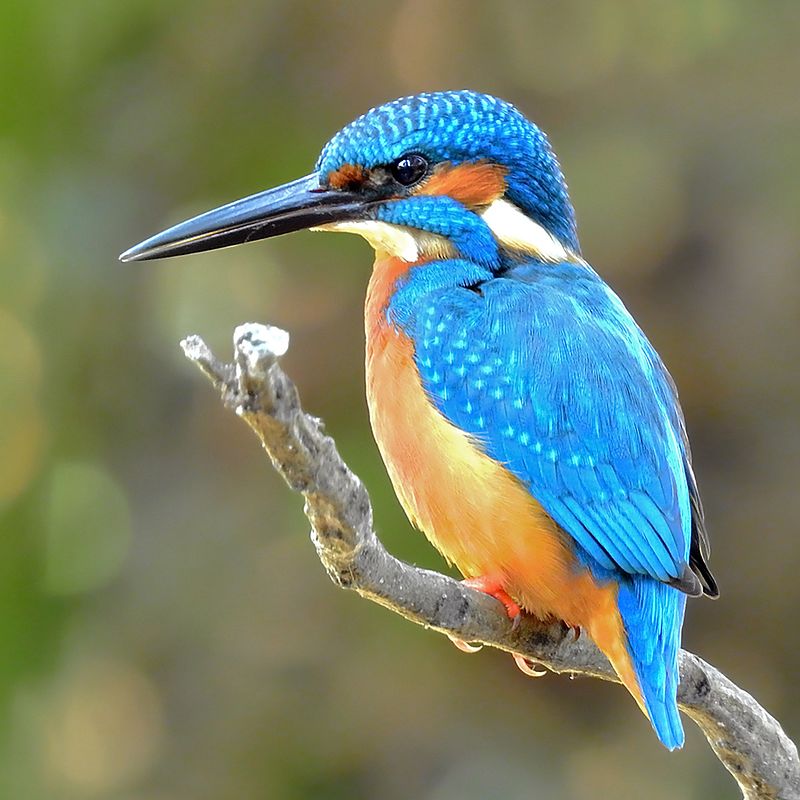
The Common Kingfisher is a small, sparrow-sized bird that can be found across Eurasia and North Africa. It has the typical short tail and large head of kingfishers with seven different subspecies recognized in its range.
They are mainly resident birds but will migrate away during winter when rivers freeze over. The species usually live near bodies of water such as streams or lakes.
Where they hunt for fish by diving from above into the water after spotting their prey below them.
These brightly coloured birds have an unmistakable vibrant blue plumage along with orange underparts and white patches on their wings which makes them easy to recognize amongst other similar looking species.
Their call is loud and shrill making it one of the most recognizable sounds heard around wetlands throughout Europe.Scientific classification:
| Kingdom | Animalia |
| Phylum | Chordata |
| Class | Aves |
| Order | Coraciiformes |
| Family | Alcedinidae |
| Subfamily | Alcedininae |
| Genus | Alcedo |
| Species | A. atthis |
27. Red-Backed Shrike
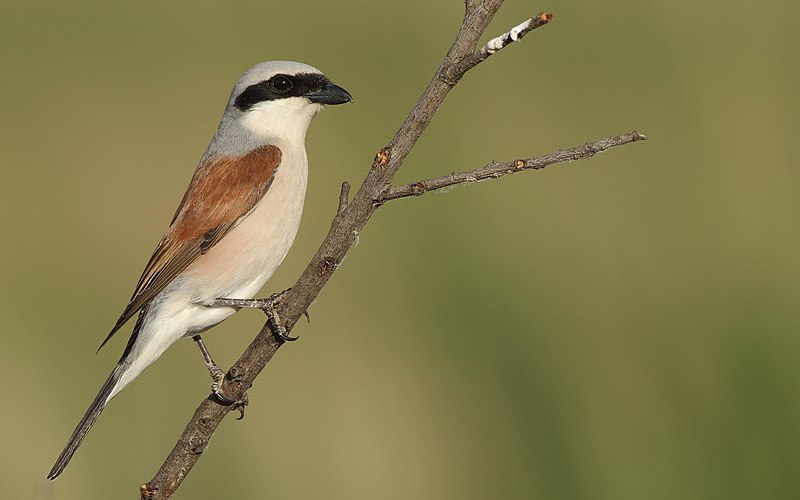
The Red-backed Shrike is a beautiful member of the shrike family, found in western Europe and central Russia. It is easily identified by its gray mantle, black wings with white spots and red back.
In summer it migrates to eastern tropical Africa or southern Africa where they overwinter.
This bird feeds mainly on insects but also eats small mammals, reptiles and other birds as well as fruit occasionally.
They are known for their hunting techniques which include perching high up in trees then diving down onto their prey below them before returning to eat it at leisure elsewhere.
The Red-backed Shrike is an impressive sight that lives both in our gardens and far away places.Scientific classification:
| Kingdom | Animalia |
| Phylum | Chordata |
| Class | Aves |
| Order | Passeriformes |
| Family | Laniidae |
| Genus | Lanius |
| Species | L. collurio |
28. Eurasian Wryneck
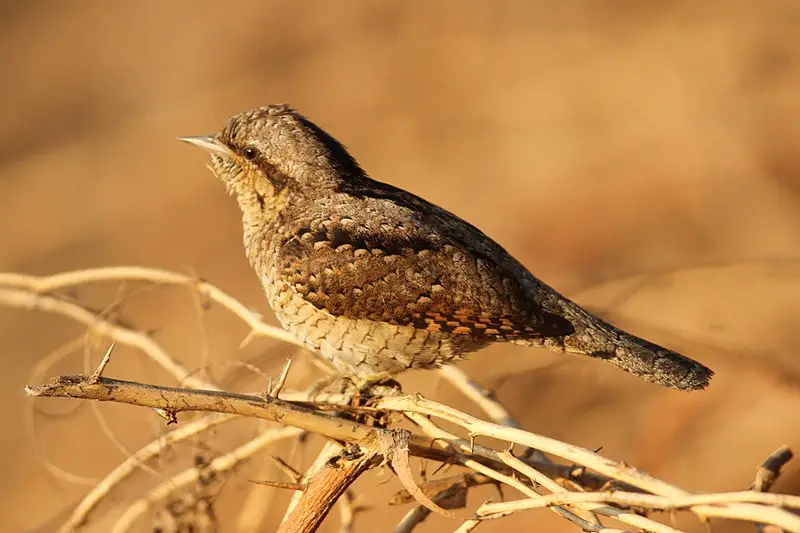
The Eurasian Wryneck is a species of woodpecker found in temperate regions of Europe and Asia. They breed during the summer months, but migrate south to tropical Africa or southern Asia for winter.
These birds are quite adaptable when it comes to their habitat, as they can be seen in open countryside, woodland, orchards and gardens alike.
To identify them you should look out for their distinctive brownish-grey feathers with black bars on the wings and tail; males also have red markings around their neck too.
Their diet consists mainly of insects which they find by probing into loose bark on trees or digging through soil with its sharp bill.
All in all an amazing bird that deserves more attention.Scientific classification:
| Kingdom | Animalia |
| Phylum | Chordata |
| Class | Aves |
| Order | Piciformes |
| Family | Picidae |
| Genus | Jynx |
| Species | J. torquilla |
29. Water Rail
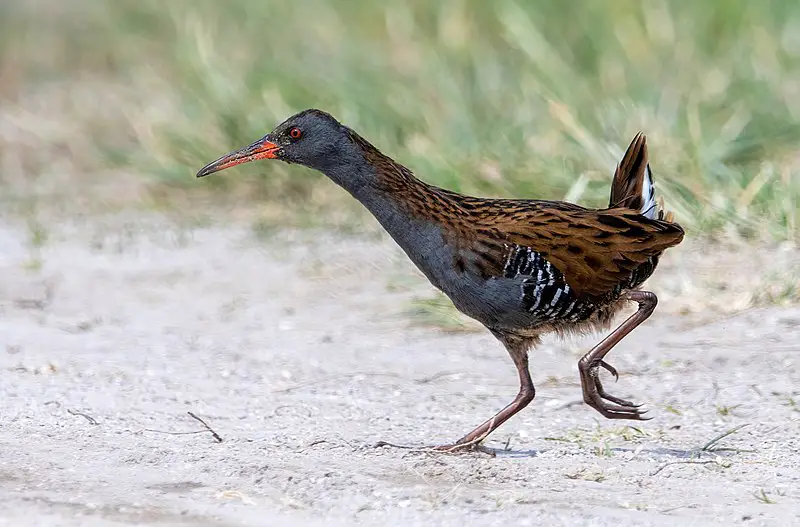
The Water rail is a member of the Rallidae bird family, which inhabits wetlands with dense vegetation. It has a flattened body to aid it in its wetland habitat; this helps it move through long grass and reeds easily.
Adults measure 23-28 cm (9-11 inches) in length and they can be found throughout Europe, Asia and North Africa.
Northern and eastern populations are migratory whereas southern ones remain permanent residents year round.
The bird’s diet consists mainly of insects, small fish, worms, molluscs as well as some plant material like grains or seeds.
Its feathers have an overall brownish grey colouration while its belly is white or creamy yellow with dark markings around the edges of each feather that gives them camouflage against their environment when seen from above or below water level respectively.Scientific classification:
| Kingdom | Animalia |
| Phylum | Chordata |
| Class | Aves |
| Order | Gruiformes |
| Family | Rallidae |
| Genus | Rallus |
| Species | R. aquaticus |
30. Eurasian Scops Owl
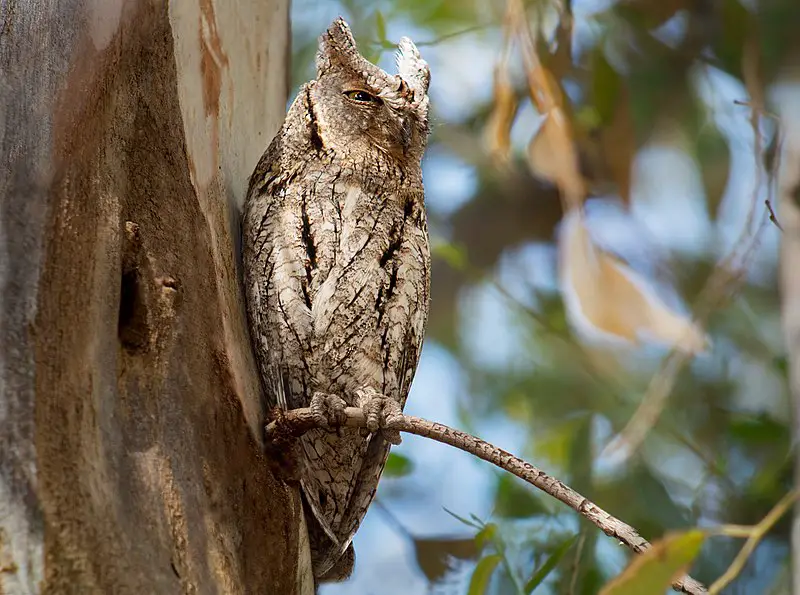
The Eurasian scops owl is a small bird in the Strigidae family. It’s breeding range stretches from southern Europe to Southern Siberia and into western Himalayas.
During winter, it migrates south of the Sahara Desert in Africa. This species was formally described by Swedish naturalist Carl Linnaeus back in 1758.
They have ear tufts on their head which are actually feathers used for camouflage among tree branches; they also provide visual communication between other owls nearby – an important part of survival.
The Eurasian Scops Owl typically eats insects such as crickets, beetles and moths found around its habitat.
These birds make sure that our environment stays balanced with nature by keeping insect populations down.Scientific classification:
| Kingdom | Animalia |
| Phylum | Chordata |
| Class | Aves |
| Order | Strigiformes |
| Family | Strigidae |
| Genus | Otus |
| Species | O. scops |
31. Black Grouse
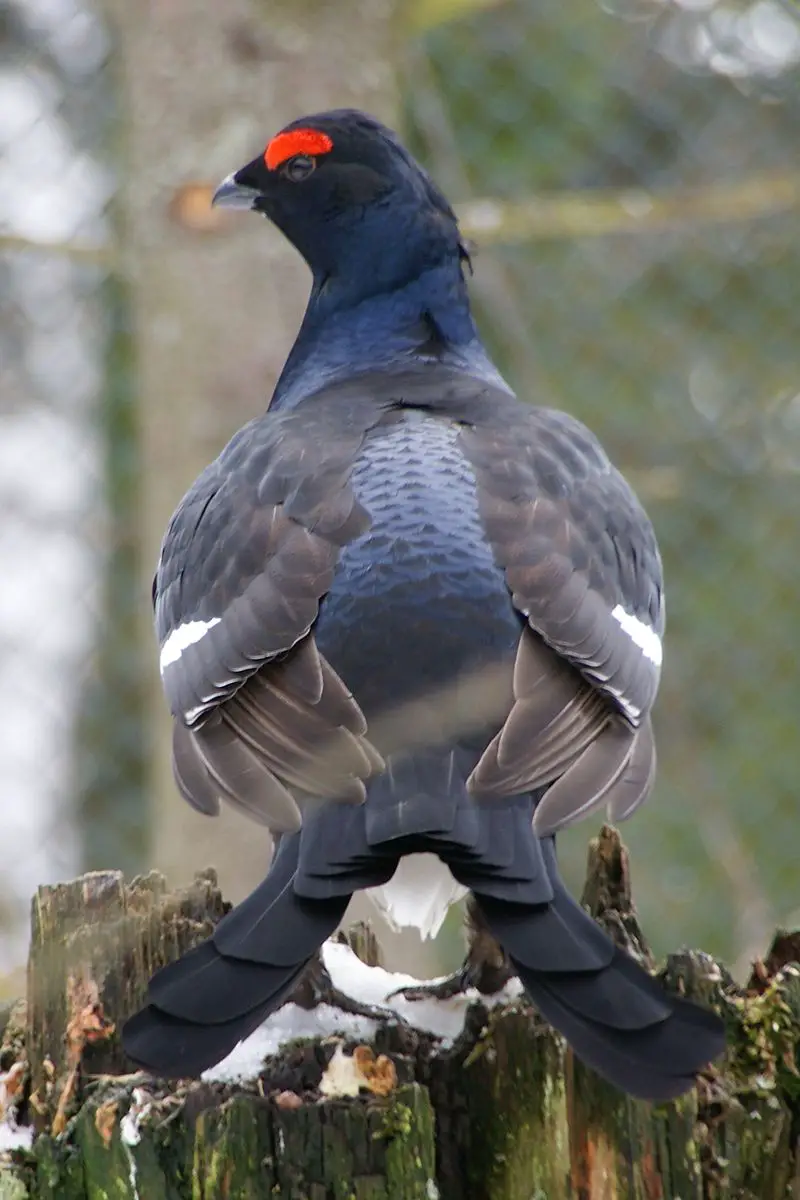
The black grouse is a large bird in the grouse family. It lives mainly in moorland and steppe habitats, often near wooded areas. In winter, it moves to dense forests where its diet consists almost exclusively of conifer needles.
These birds have an impressive wingspan of up to 75 cm wide, with males boasting dark metallic plumage and white tail feathers that they display during courtship rituals known as ‘leks’. Females are smaller than males with more brownish-grey coloured feathers.
Both sexes possess red combs above their eyes which become brighter during mating season – along with yellow wattles on their throats.
The black grouse is considered vulnerable due to loss of habitat caused by human activity such as deforestation and agricultural practices.Scientific classification:
| Kingdom | Animalia |
| Phylum | Chordata |
| Class | Aves |
| Order | Galliformes |
| Family | Phasianidae |
| Genus | Lyrurus |
| Species | L. tetrix |
32. Willow Tit
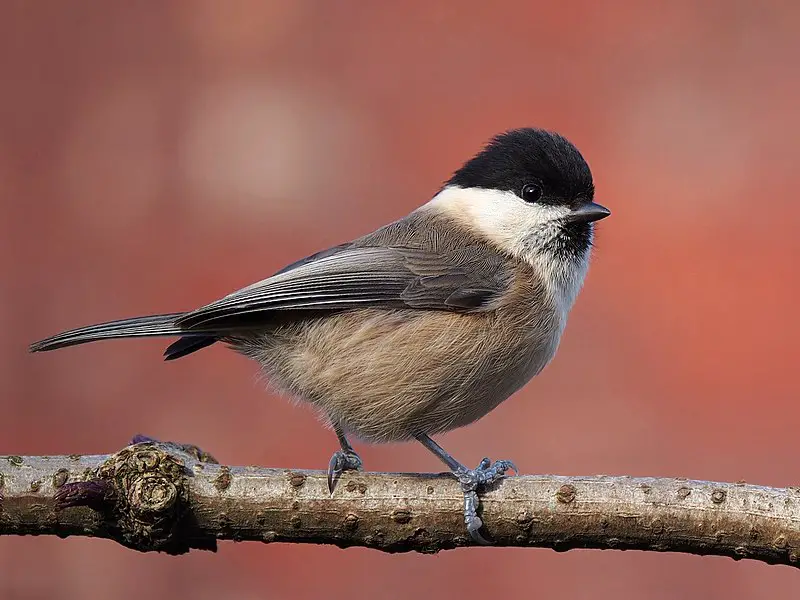
The Willow Tit is a passerine bird belonging to the tit family, Paridae. It has grey-brown and off-white plumage with a black cap and bib.
This species is widely distributed across temperate regions of Europe, subarctic parts of Eurasia and Palearctic areas.
It usually resides in coniferous forests or adjacent habitats such as young birch woodland.
The Willow Tit prefers open stands of trees compared to its relative Marsh Tit which explains why it can be found further north than other species while still thriving successfully all year round.
Its diet consists mainly of insects but also includes seeds, nuts and berries during winter months when food sources are scarce making them very adaptable birds indeed.Scientific classification:
| Kingdom | Animalia |
| Phylum | Chordata |
| Class | Aves |
| Order | Passeriformes |
| Family | Paridae |
| Genus | Poecile |
| Species | P. montanus |
Also Featured In: Willows Birds Around You,
33. Alpine Accentor
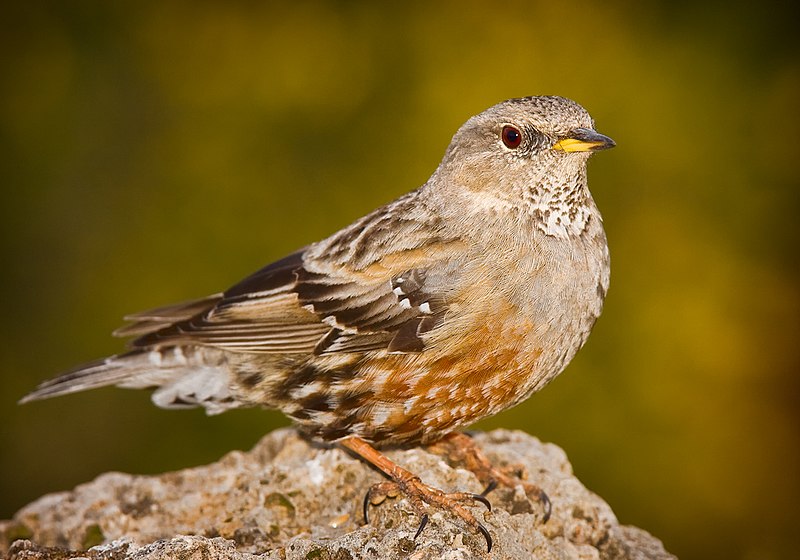
The Alpine Accentor is a small passerine bird belonging to the Prunellidae family. It is native to Eurasia and North Africa, first described by Austria naturalist Giovanni Antonio Scopoli in 1769 with its type locality being Carinthia region of southern Austria.
The species name “collaris” was derived from Latin which means “of a collar” referring to the black line running across their white breast feathers resembling that of a collar.
They are approximately 12-13 cm long and have rounded wings, short tails, thick bill and greyish brown upperparts as well as whitish under parts with yellow tinge on flanks.
They feed primarily on insect larvae found near ground level or other invertebrates such as spiders and worms scattered around alpine meadows where they breed during summer months between May – August before migrating southwards for winter season when food sources become scarce above snowline at higher altitudes.Scientific classification:
| Kingdom | Animalia |
| Phylum | Chordata |
| Class | Aves |
| Order | Passeriformes |
| Family | Prunellidae |
| Genus | Prunella |
| Species | P. collaris |
Also Featured In: Common Slovakian Birds, Asian Birds
34. Dunnock
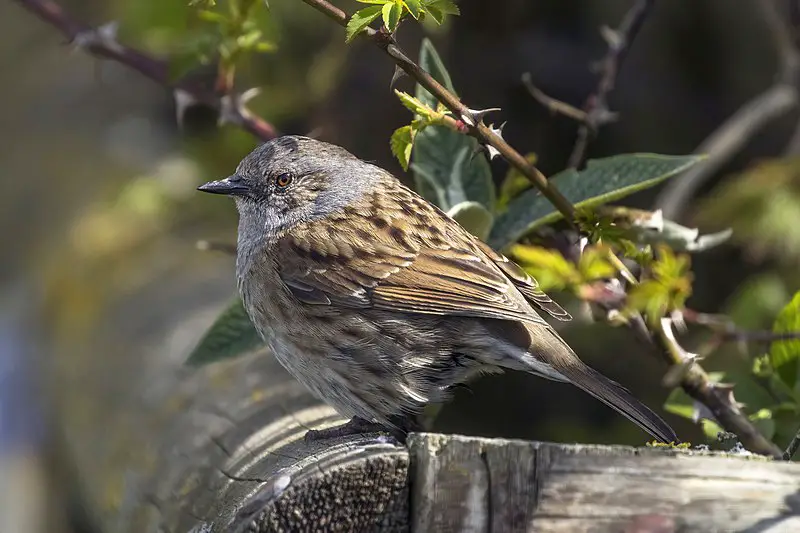
The Dunnock, also known as the Hedge Accentor, Hedge Sparrow and Hedge Warbler, is a small passerine bird found in temperate climates of Europe and Asia.
It has even been successfully introduced to New Zealand. The Dunnock stands out amongst its family members as it can thrive in many different habitats beyond just mountainous areas – making it more widespread than other birds of its kind.
With greyish-brown upper parts and whitish underparts with brown streaks on them; they are easily distinguished from their fellow species by their distinctive saucy call.
Often seen searching for food on the ground or darting around bushes looking for insects and worms; these lively little birds make an attractive addition to any garden or parkland setting.Scientific classification:
| Kingdom | Animalia |
| Phylum | Chordata |
| Class | Aves |
| Order | Passeriformes |
| Family | Prunellidae |
| Genus | Prunella |
| Species | P. modularis |
35. Black-Throated Loon
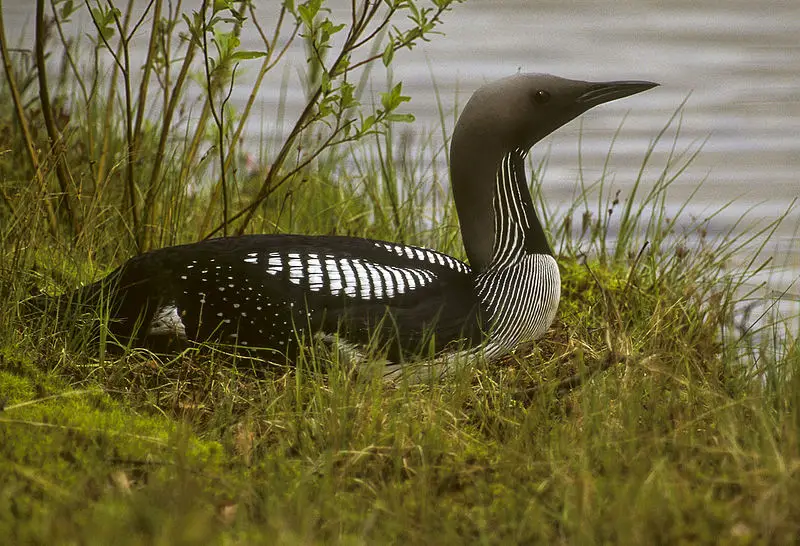
The black-throated loon is an impressive migratory bird, found in the northern hemisphere. During breeding season, these loons prefer freshwater lakes of Europe and Asia as their home.
In winter, they migrate to sheltered coastlines on both sides of the Atlantic Ocean and Pacific Ocean which remain free from ice during that time.
First described by renowned botanist Carl Linnaeus in 1758, this species has a unique appearance with its slender body covered mostly in grey feathers paired with white patches around its neck region along with a contrasting black throat patch giving it its name – The Black-Throated Loon.
These birds are also known for their elegant swimming style while hunting small fish underwater making them one of nature’s most fascinating creatures.Scientific classification:
| Kingdom | Animalia |
| Phylum | Chordata |
| Class | Aves |
| Order | Gaviiformes |
| Family | Gaviidae |
| Genus | Gavia |
| Species | G. arctica |
Also Featured In: Tundra Birds, Birds That Live in Benbecula You Should Know
36. Peregrine Falcon
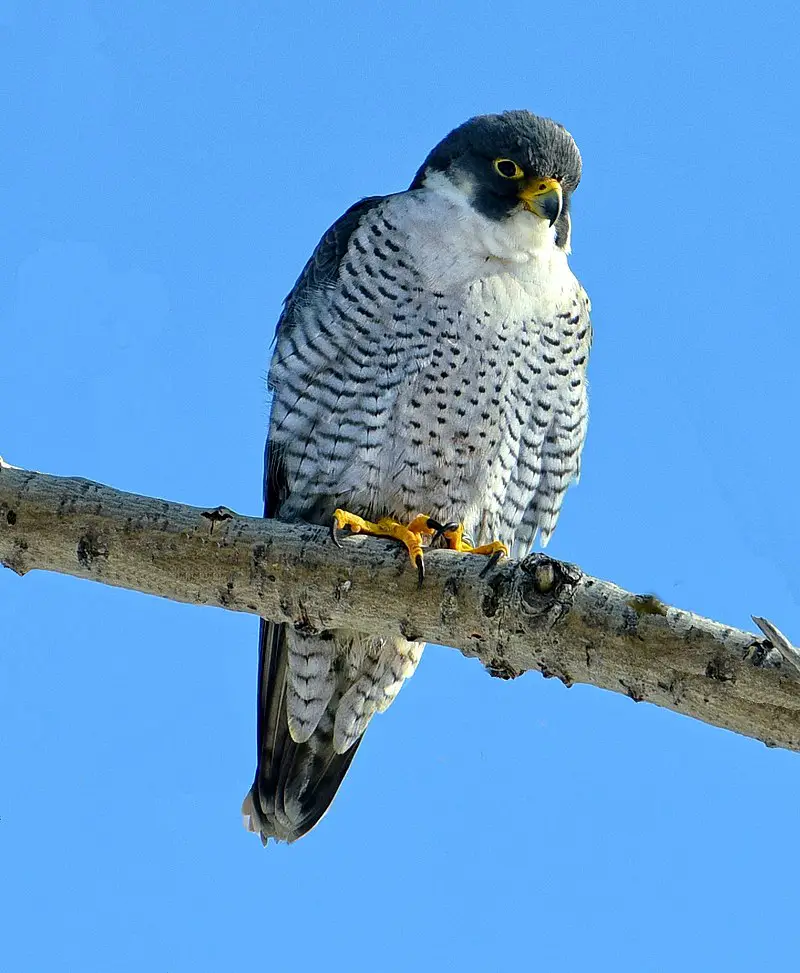
The Peregrine Falcon is a majestic bird of prey belonging to the family Falconidae. It has a blue-grey back, barred white underparts and black head making it easily recognizable.
This intelligent raptor is known for its incredible speed reaching over 320 km/h (200 mph) during hunting dives – one of the fastest animals in existence.
The peregrine falcon can be found around the world from Arctic tundra to tropical rainforests thriving with humans or in high alpine mountains far away from civilization.
With their beauty, power and adaptability they are an impressive species that have earned respect among many cultures throughout history as symbols of strength and endurance.Scientific classification:
| Kingdom | Animalia |
| Phylum | Chordata |
| Class | Aves |
| Order | Falconiformes |
| Family | Falconidae |
| Genus | Falco |
| Species | F. peregrinus |
37. White Wagtail
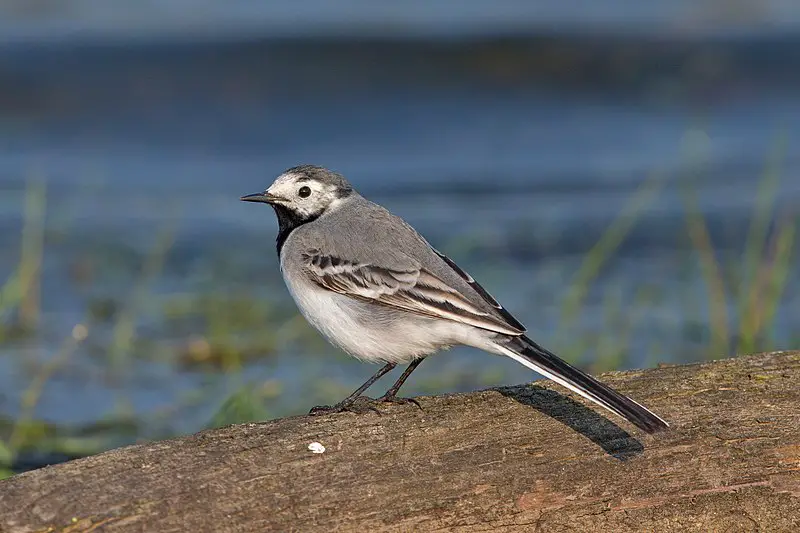
The White Wagtail is a small passerine bird that belongs to the Motacillidae family, which includes pipits and longclaws. This species breeds in Europe, Asia Palearctic and North Africa.
It has also been seen as a scarce breeder in Alaska. Those living in mild climates are found year-round but others migrate south for winter months to Africa.
In Ireland and Great Britain it’s known for its darker subspecies called Pied Wagtails with their distinctive white heads, grey backs and yellow breasts.
They feed on insects such as flies, beetles or spiders by wagging their tail up & down while they walk along surfaces like tree trunks or walls looking out for prey – hence receiving this name.
To attract mates they sing melodic songs from high perches too.Scientific classification:
| Kingdom | Animalia |
| Phylum | Chordata |
| Class | Aves |
| Order | Passeriformes |
| Family | Motacillidae |
| Genus | Motacilla |
| Species | M. alba |
38. Spotted Flycatcher
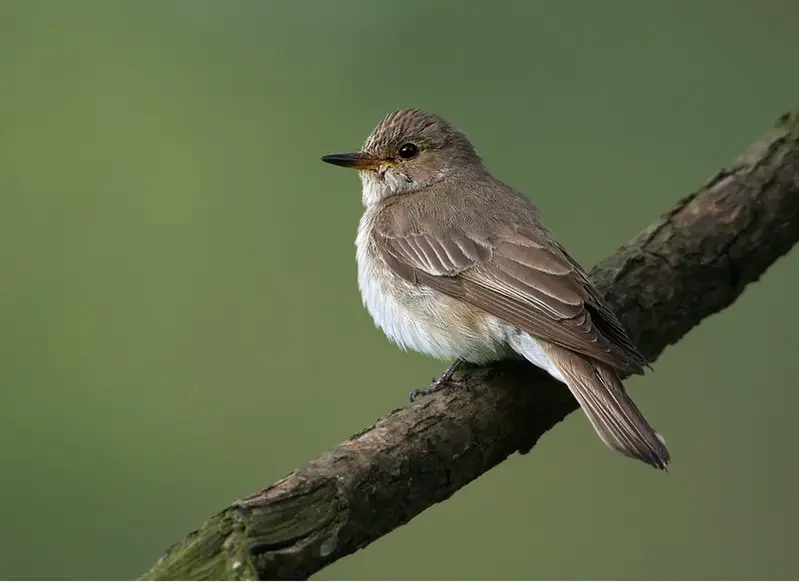
The Spotted Flycatcher is a small passerine bird belonging to the Old World flycatcher family. It has grey-brown upperparts and whitish underparts, with two white wing bars on its wings and tail.
The adult also has an eye ring of pale brown or buff coloration around their eyes. This species breeds in most parts of Europe, Siberia and Palearctic regions, before migrating south for wintering in Africa and South Western Asia.
Unfortunately it is declining due to loss of habitat caused by deforestation and intensive agriculture practices over much of its range but some conservation measures have been taken which are helping this species recover somewhat from these declines.Scientific classification:
| Kingdom | Animalia |
| Phylum | Chordata |
| Class | Aves |
| Order | Passeriformes |
| Family | Muscicapidae |
| Genus | Muscicapa |
| Species | M. striata |
39. Mallard
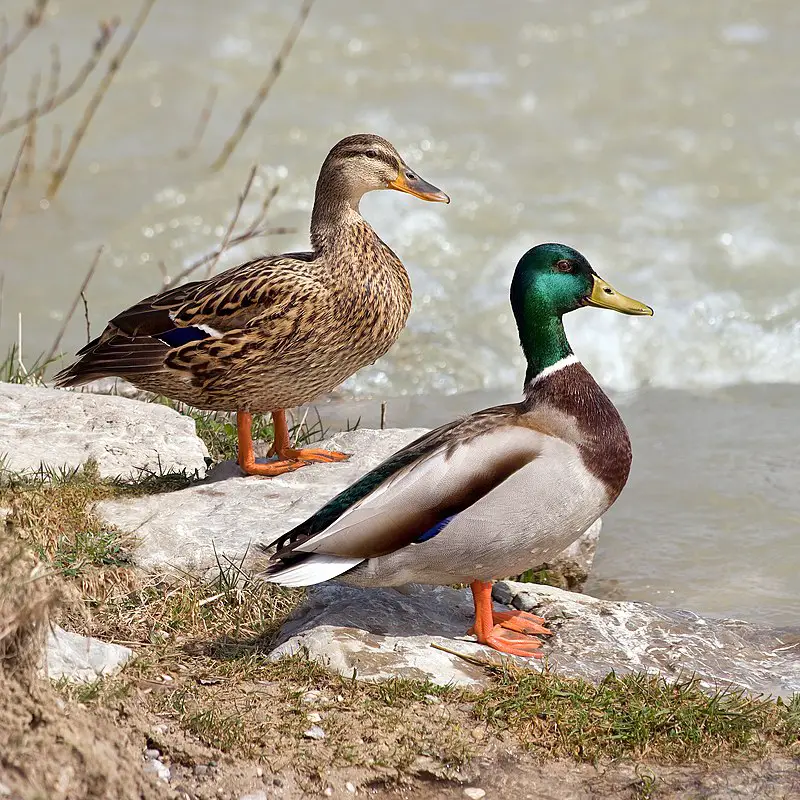
The Mallard is a species of dabbling duck that can be found living in temperate and subtropical regions across the Americas, Eurasia and North Africa.
It has been introduced to other areas such as New Zealand, Australia, Peru, Brazil and South Africa by humans.
This beautiful bird belongs to the Anatinae subfamily of waterfowl family Anatidae. The adult mallards have a glossy green head with white neck ring surrounding.
It along with brownish grey body feathers making them look stunning when they fly away or just sitting in their natural habitat around lakes or ponds.
They are excellent swimmers too due to webbed feet which helps them swim fast underwater while looking for food like aquatic insects etc.. Their loud quacking sound makes them quite popular among nature lovers.Scientific classification:
| Kingdom | Animalia |
| Phylum | Chordata |
| Class | Aves |
| Order | Anseriformes |
| Family | Anatidae |
| Genus | Anas |
| Species | A. platyrhynchos |
40. Bustard
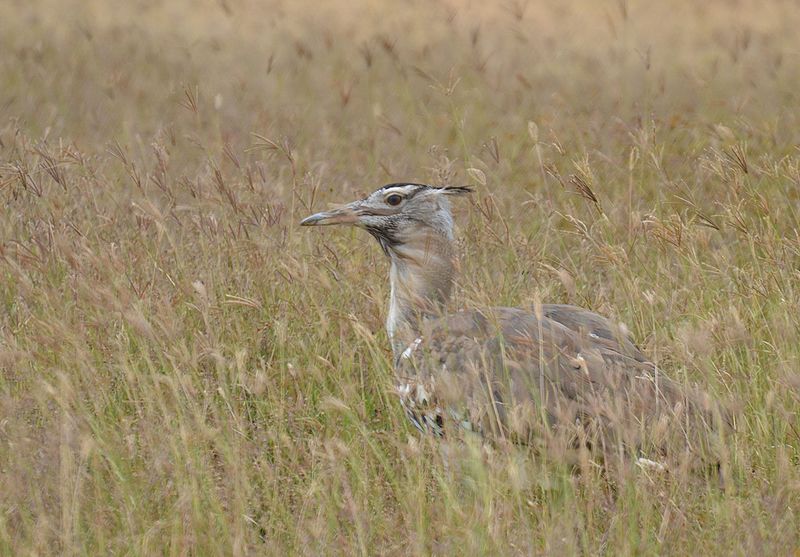
Bustards are large, terrestrial birds that inhabit dry grassland areas and the steppes of the Old World. They range from 40-150 cm in length and belong to the family Otididae.
Bustards have an omnivorous diet consisting of leaves, buds, seeds, fruit as well as small vertebrates and invertebrates.
These birds usually live a solitary life but can be seen gathering around water sources or food during certain times of year such as mating season.
Due to their large size they are vulnerable to predation by foxes or other animals which is why they tend to remain alert at all times.
When in open spaces while relying on camouflage for protection against predators when out in tall vegetation coverings.Scientific classification:
| Kingdom | Animalia |
| Phylum | Chordata |
| Class | Aves |
| Clade | Otidimorphae |
| Order | Otidiformes Wagler, 1830 |
| Family | Otididae Rafinesque, 1815 |
41. Phasianidae
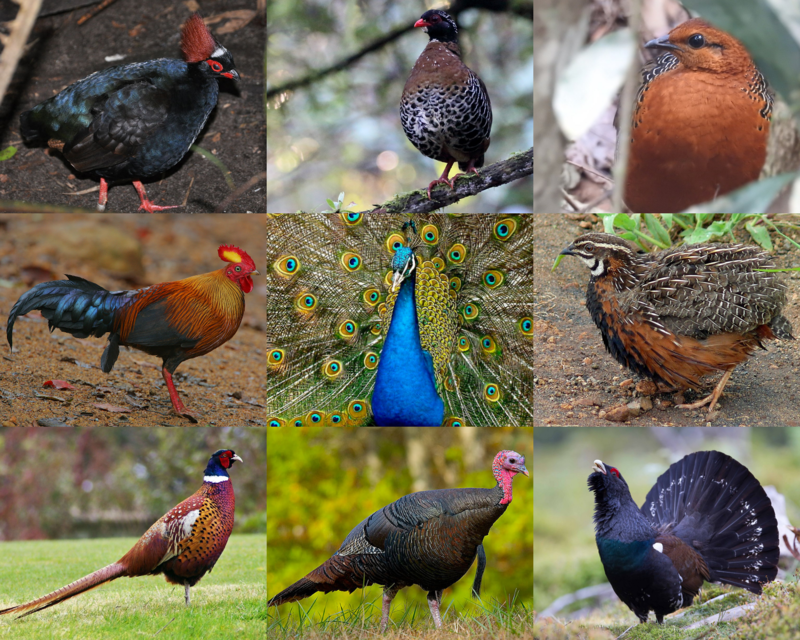
The Phasianidae family of birds is one that contains many popular gamebirds, with a total of 185 species divided across 54 genera.
These heavy ground-living birds include pheasants, partridges, junglefowl, chickens, and turkeys among others like Old World quail and peafowl.
This large family was formerly split into two subfamilies known as the Phasianinae and Perdicinae but this classification has since been changed to reflect more current scientific findings on them.
All these different types of birds have certain things in common such as their strong legs for scratching through leaves or soil looking for food items including insects, seeds, and other vegetation which makes up most of their diet.
They also all tend to be quite colorful in order to attract mates during breeding season when males will often display vibrant feathers or do dances around females in an attempt at courtship ritual displays.
The majority are monogamous creatures too although some may form short-term pair bonds before going off alone again once mating has taken place – either way.
There tends to be very little parental care given by adults after eggs have hatched so chicks need to fend for themselves right away.Scientific classification:
| Kingdom | Animalia |
| Phylum | Chordata |
| Class | Aves |
| Order | Galliformes |
| Superfamily | Phasianoidea |
| Family | Phasianidae Horsfield, 1821 |
42. Treecreepers

Treecreepers are small passerine birds found in wooded areas of the Northern Hemisphere and sub-Saharan Africa.
They have dull colored plumage, long curved bills, stiff tails and strong feet that help them to climb up tree trunks while searching for food such as insects and spiders.
The two genera Certhia and Salpornis include eleven species which can be identified by their distinct call – a high pitched ‘tsee-tsit’.
Treecreepers build cup shaped nests on trees usually near the base or middle trunk using mosses, lichens, grasses with leaves inside them to provide insulation from cold temperatures.
These birds also use bark crevices during winter months when they shelter in groups together against extreme weather conditions.Scientific classification:
| Kingdom | Animalia |
| Phylum | Chordata |
| Class | Aves |
| Order | Passeriformes |
| Superfamily | Certhioidea |
| Family | Certhiidae Leach, 1820 |
43. Bean Goose
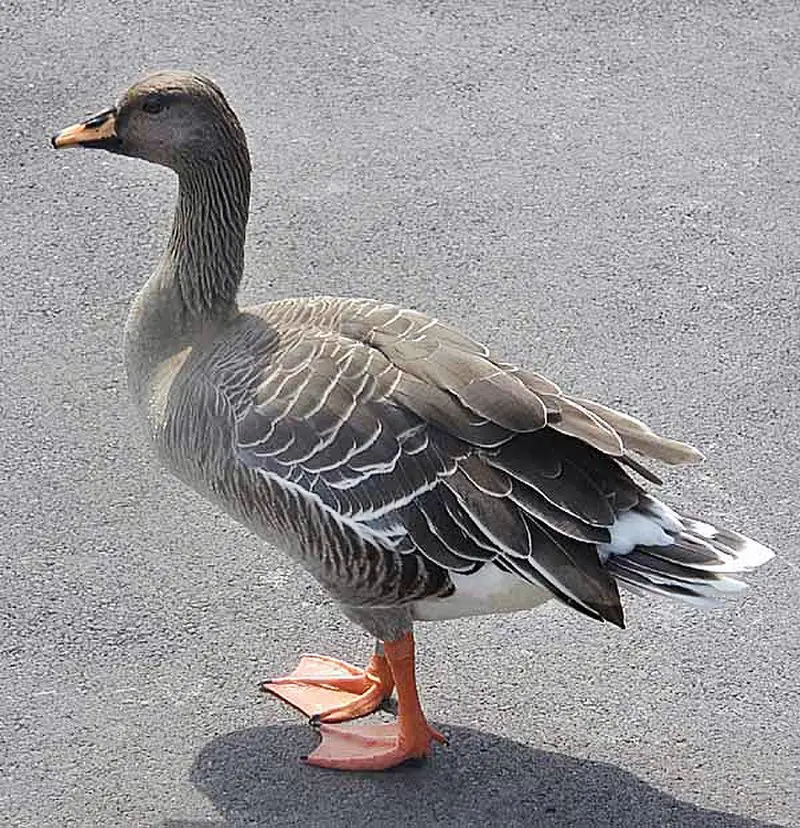
The Taiga Bean Goose is a medium sized waterfowl species that breeds in northern Europe and Asia. It has an elegant grey-brown plumage with black barring on its wings and tail, which makes it easy to identify amongst other geese.
In the winter months, this migratory bird moves further south for warmer climates.
The American Ornithological Society recognizes two subspecies of bean goose – tundra bean goose and taiga bean goose whereas some other authorities consider them as one species.
The diet of this majestic creature mainly consists of aquatic plants such as grasses, sedges or cereals depending upon season availability during migration periods.Scientific classification:
| Kingdom | Animalia |
| Phylum | Chordata |
| Class | Aves |
| Order | Anseriformes |
| Family | Anatidae |
| Genus | Anser |
| Species | A. fabalis |
44. Black-Necked Grebe

The Black-necked Grebe is a beautiful water bird belonging to the grebe family. It has an ochre coloured plumage with distinctive features which include extending behind its eyes and over its ear coverts.
The upper parts of this species are black, while their underparts and neck are white in colour.
During breeding season, males develop a dark grey crown on top of their head along with bright yellow facial stripes that run from the beak down to it’s chest area.
These birds feed mainly by diving underwater for insects, crustaceans, larvae, molluscs as well as small fish that they find in shallow waters or wetlands near freshwater lakes or streams.
They can often be spotted swimming alone but during winter months gather together creating large flocks due to mating activity taking place at these times.Scientific classification:
| Kingdom | Animalia |
| Phylum | Chordata |
| Class | Aves |
| Order | Podicipediformes |
| Family | Podicipedidae |
| Genus | Podiceps |
| Species | P. nigricollis |
45. Black-Crowned Night Heron
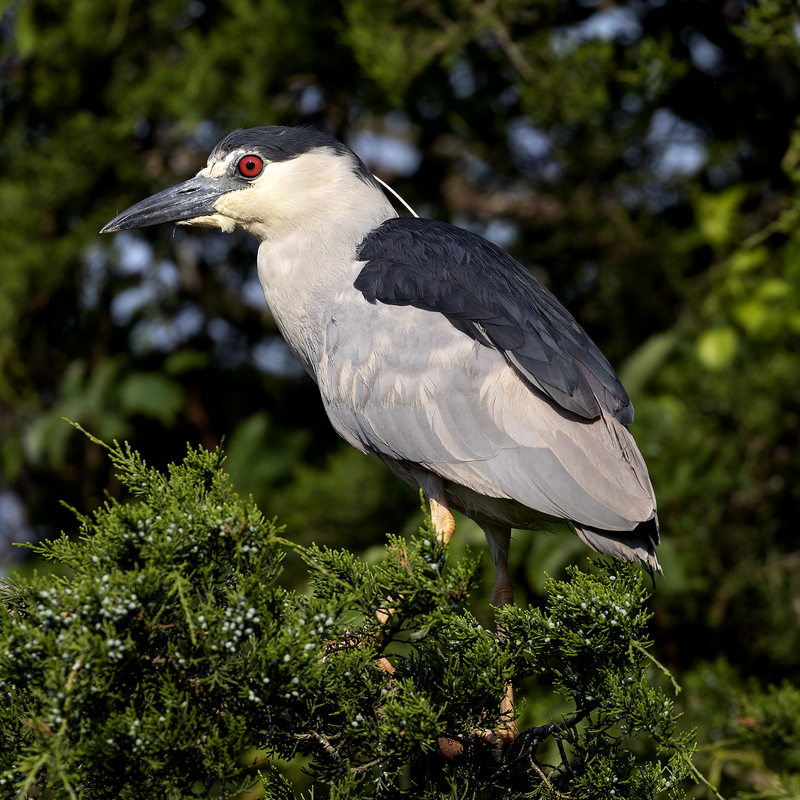
The Black-crowned night heron (Nycticorax nycticorax) is a medium-sized bird found in various parts of the world, including Europe, Asia and North and South America.
It has black crowns on its head with white feathers underneath. Its wings are greyish brown while its underparts are mostly white.
This species can be seen foraging near shallow water or along coastlines during dusk or dawn as it hunts small fish, amphibians and crustaceans.
They also feed on insects such as grasshoppers and beetles which they find in meadows close to freshwater bodies like lakes or ponds where they breed during springtime making nests using twigs lined with reeds and leaves near these waterside habitats.
In Australasia, this species hybridizes with the nankeen night heron that inhabits those areas instead; however both populations remain distinct from each other despite their overlap range regions.Scientific classification:
| Kingdom | Animalia |
| Phylum | Chordata |
| Class | Aves |
| Order | Pelecaniformes |
| Family | Ardeidae |
| Genus | Nycticorax |
| Species | N. nycticorax |
Also Featured In: Birds of Kauai, Hawaii, Flight Birds You Should Know
46. Plovers

Plovers are a family of around 64-68 species of ground-dwelling birds, commonly found in open country such as fields, meadows and tundras.
They have short bills with webbed feet to help them forage through mud or shallow water.
Plover plumage is usually mottled brown though some species may have brighter colors on the head and wings.
These birds feed mainly on insects but can also eat small crustaceans and worms.
Plovers breed during springtime when they dig holes in sandy or pebbled beaches to lay their eggs which hatch after about 3 weeks incubation period.
They use distraction display behaviour by pretending an injury to the predators away from their nests if needed for protecting their young ones.Scientific classification:
| Kingdom | Animalia |
| Phylum | Chordata |
| Class | Aves |
| Order | Charadriiformes |
| Family | Charadriidae Leach, 1820 |
47. Phylloscopidae
The Phylloscopidae bird family is made up of small to medium-sized insectivorous birds. They are found in most parts of the world, including Europe, Asia and North Africa.
These birds have slender bodies with long wings and legs; they also possess a distinctive supercilium or eyebrow stripe above their eyes.
Their diet consists mainly of insects such as flies, moths and grasshoppers which they catch while hovering over open ground or foliage.
Most species live in forests but some inhabit more open areas such as scrubland and meadows. The chatter calls emitted by these birds often helps them locate food sources as well as alerting other members of their flock when danger is present.
They can be identified from other passerines due to their olive green upperparts combined with pale yellow underparts that contrast sharply against each other making them very visible even from afar.
48. Bee-Eater
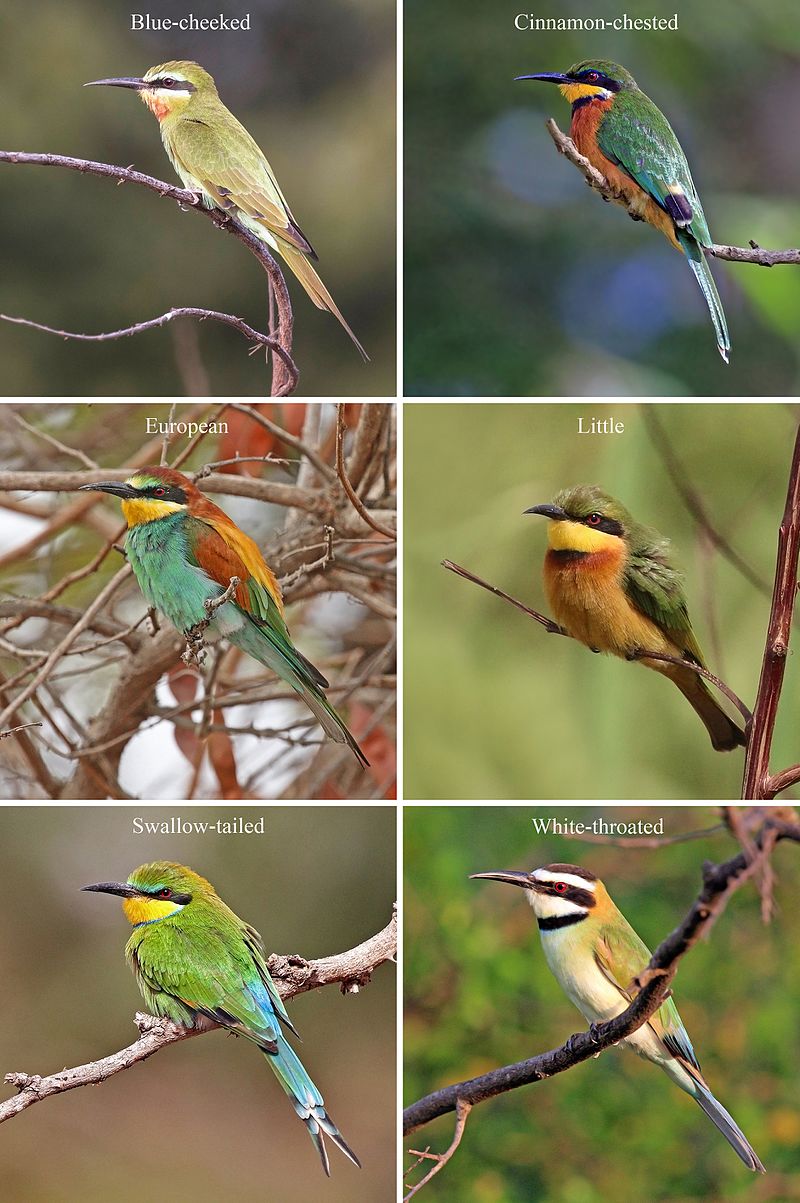
Bee-eaters are one of the most beautiful and vibrant birds in existence. They have a slender body, long wings, down turned bills and their signature elongated central tail feathers which make them instantly recognizable from afar.
Their plumage is incredibly colorful with many shades ranging from blues to greens to reds that glisten when they fly through the air.
These stunning creatures can be found all over Africa, Asia, Southern Europe, Australia and New Guinea where they feed mainly on bees but also other insects like flies or wasps as well as small mammals such as lizards or rodents.
Bee-eaters live in colonies near rivers or wetlands so that they may easily hunt for food while staying close together for safety purposes.
Additionally it allows them to better display their impressive courtship dances during mating season.Scientific classification:
| Kingdom | Animalia |
| Phylum | Chordata |
| Class | Aves |
| Order | Coraciiformes |
| Family | Meropidae Rafinesque, 1815 |
49. Sittidae
The Phylloscopidae bird family is made up of small to medium-sized insectivorous birds. They are found in most parts of the world, including Europe, Asia and North Africa.
These birds have slender bodies with long wings and legs; they also possess a distinctive supercilium or eyebrow stripe above their eyes.
Their diet consists mainly of insects such as flies, moths and grasshoppers which they catch while hovering over open ground or foliage.
Most species live in forests but some inhabit more open areas such as scrubland and meadows. The chatter calls emitted by these birds often helps them locate food sources as well as alerting other members of their flock when danger is present.
They can be identified from other passerines due to their olive green upperparts combined with pale yellow underparts that contrast sharply against each other making them very visible even from afar.
50. Sandgrouse
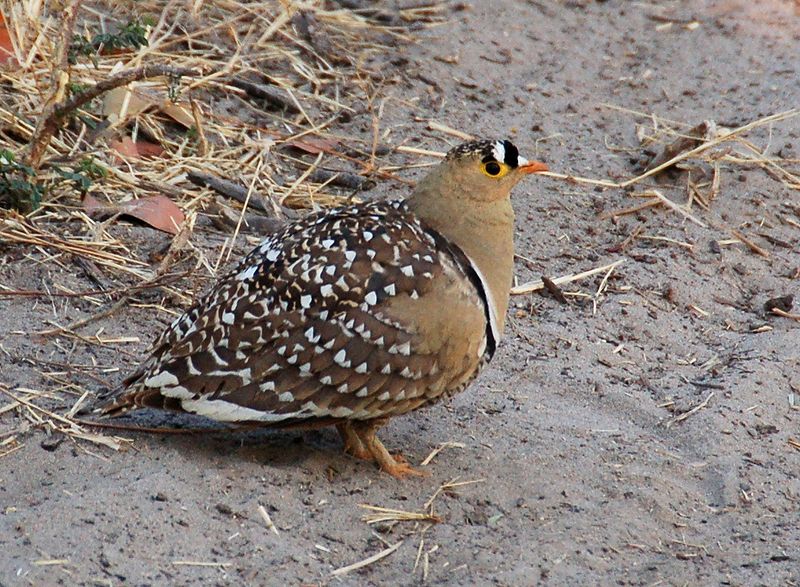
Sandgrouse is birds of the order Pterocliformes, found mainly in Africa and Asia. There are sixteen species belonging to two genera – Syrrhaptes from central Asia and Pterocles from Africa and other Asian countries.
They inhabit treeless areas such as deserts, steppes, scrubland, or savannas and tend to be ground-dwelling birds that feed on seeds.
Sandgrouse has adapted special features for survival in their harsh environment.
They possess well-developed feet with four toes used for walking over hot sand while keeping their body temperature cool at all times by regulating heat loss through their legs.
Their feathers also act like a sponge helping them absorb water before flying long distances back home where they then expel it using specialized glandular secretions located near the wings so that chicks can drink directly from an adult’s breast plumage.Scientific classification:
| Kingdom | Animalia |
| Phylum | Chordata |
| Class | Aves |
| Clade | Columbimorphae |
| Order | Pterocliformes Huxley, 1868 |
| Family | Pteroclidae Bonaparte, 1831 |
51. Hoopoes
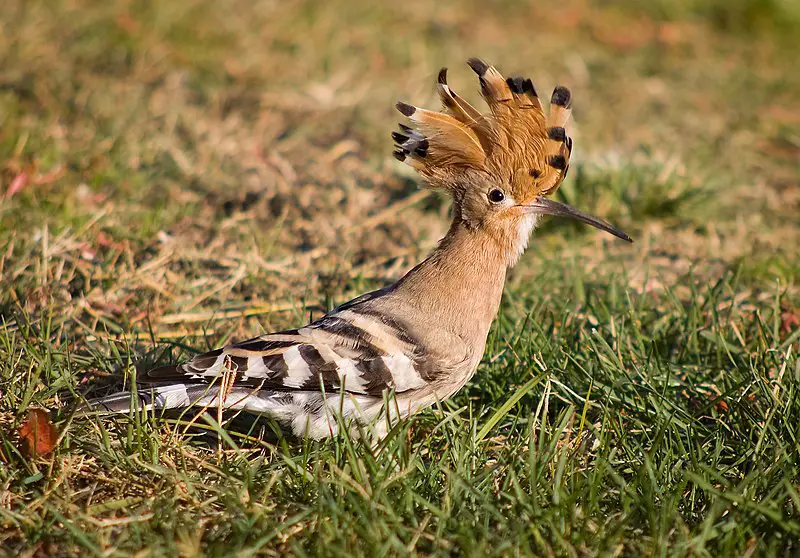
Hoopoes are a fascinating species of bird, found across Africa, Asia and Europe. They have beautiful plumage with unique ‘crowns’ of feathers on their heads.
Three living and one extinct species exist – although for some time they were all classed as the same species: Upupa epops. Some taxonomists still believe this to be true.
These birds are often associated with royalty due to the impressive crown-like crest atop their head, adding an extra element of mystery and exoticism to these creatures.
Hoopoes can also produce loud calls which sound like “hoo-poo” hence why they’ve been given such an apt name.Scientific classification:
| Kingdom | Animalia |
| Phylum | Chordata |
| Class | Aves |
| Order | Bucerotiformes |
| Family | Upupidae Leach, 1820 |
| Genus | Upupa Linnaeus, 1758 |